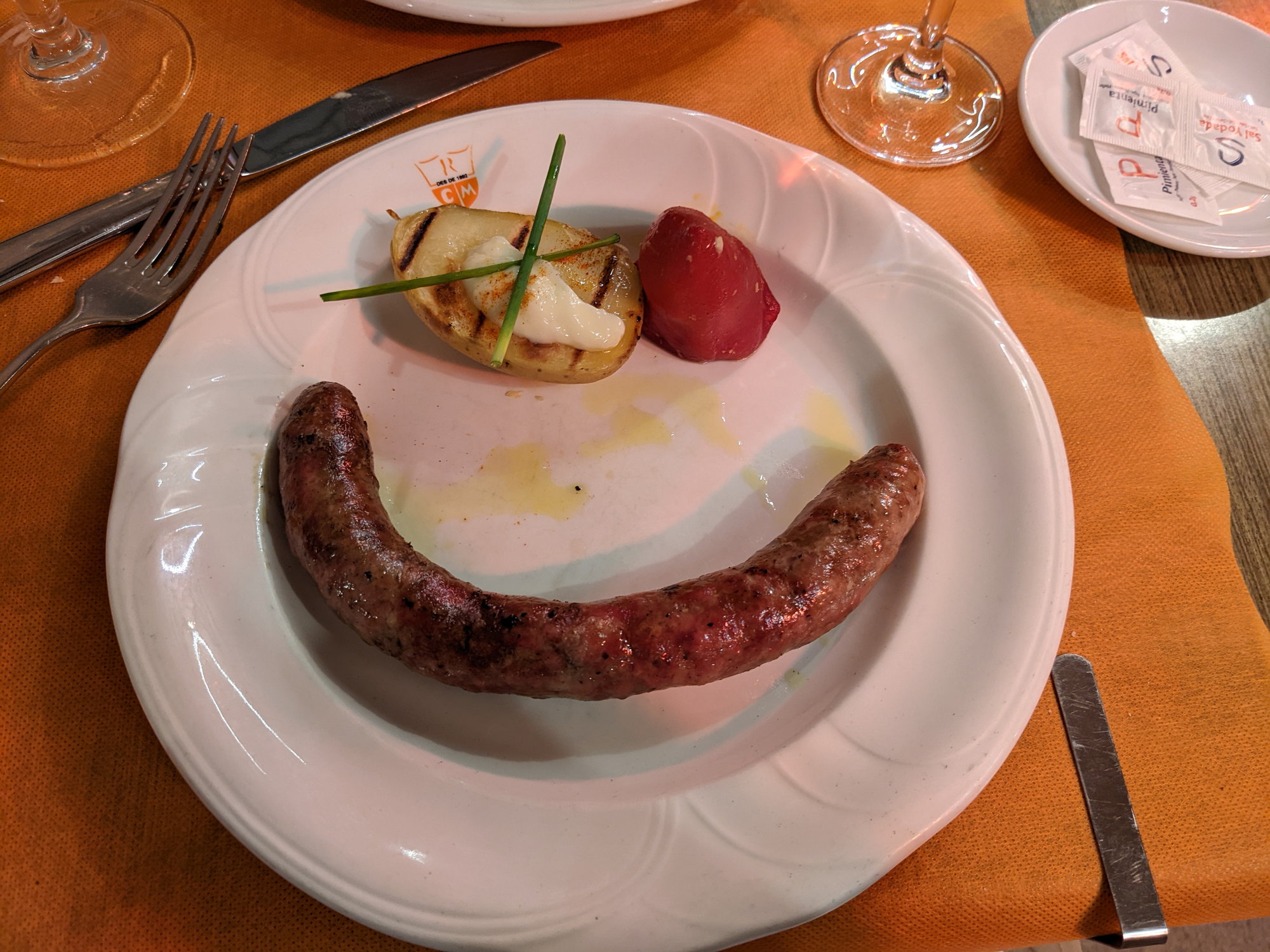Girona - yesss!
#1
Original Poster
Join Date: Aug 2013
Posts: 747
Likes: 0
Received 0 Likes
on
0 Posts
Girona - yesss!
After our days in Barcelona and Tossa de Mar (see earlier thread, "Barcelona - Slow Love"), we went to Girona. We stayed three nights and still did not see everything that this great little city has to offer. It has a fine medieval center and a large, preserved Jewish quarter, surrounded by beautiful 18th and 19th century newer areas. It's clean, friendly, and not mobbed with tourists (at least in early October when we visited).

The Placa de la Independencia, on the west bank of the Onyar river, in the newer part of the city; cross over the Eiffel bridge and you are in medieval Girona
The river Onyar cuts through the city, north-south. The medieval part of Girona lies east of the river and is quite hilly as you walk from the river. The map below shows the growth of the city since its beginnings in pre-Roman times.
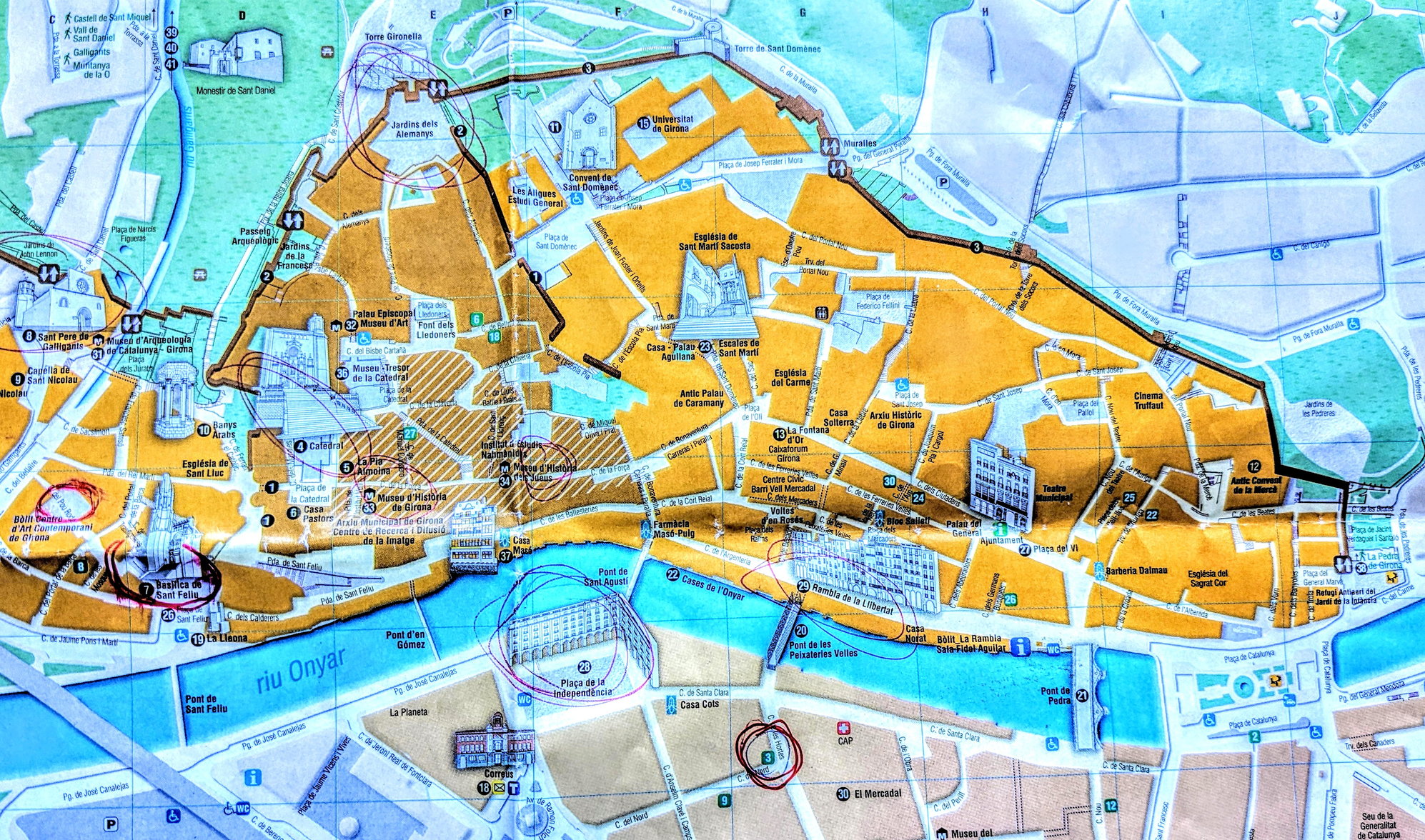
The shaded zones show different stages of the city's growth
The darkest zone is the oldest part of Girona, from pre-Roman times to about 1100 AD. The cross-hatched area is the Jewish quarter. Girona's Jewish community was one of the most important in Spain. After waves of persecution, they were expelled from Spain (or forced to convert to Catholicism) by Ferdinand and Isabella in 1492. The orange section is medieval Girona, from about 1000 to 1500 AD. The light orange area to the west of the Onyar river is the area built about 1500 to 1900 AD (in this map, "north" is on the left hand side).
The Placa de la Independencia on the west bank is lined with cafes and restaurants. Our favorite was Konig.
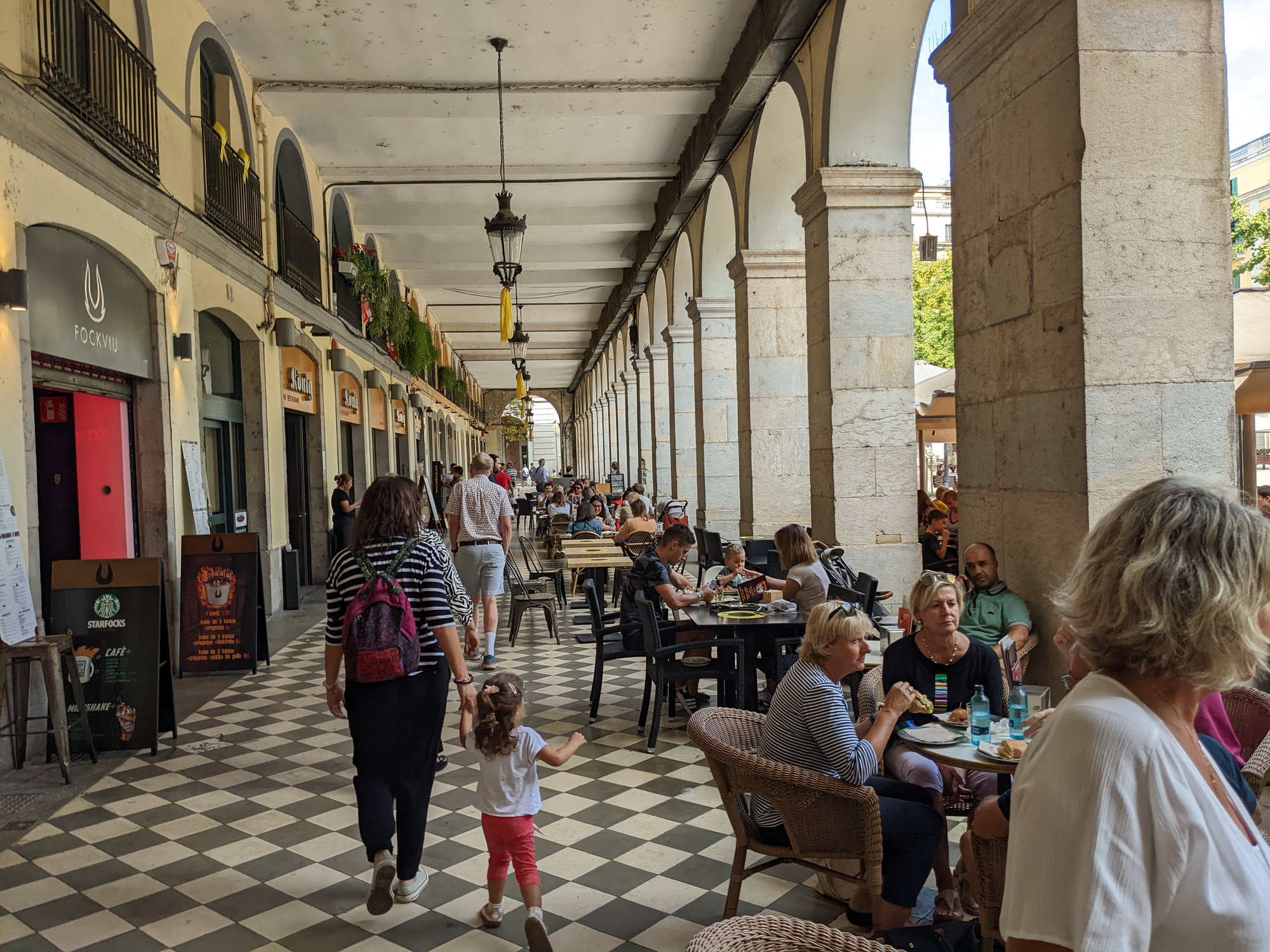
Konig cafe, on the Placa de la Independencia
Across the river to the east, just on the edge of the medieval area, is the Rambla de la Libertat, a beautiful street lined with arcades and cafes and restaurants, great for people and dog watching. From our hotel on the west bank, the Hotel Ciutat de Girona, we could walk across to the medieval quarter on the "Eiffel Bridge" (that's the popular tourist name; the formal name is Pont de les Peixateries Velles, the Old Fishmongers Bridge), built by Eiffel in 1876.
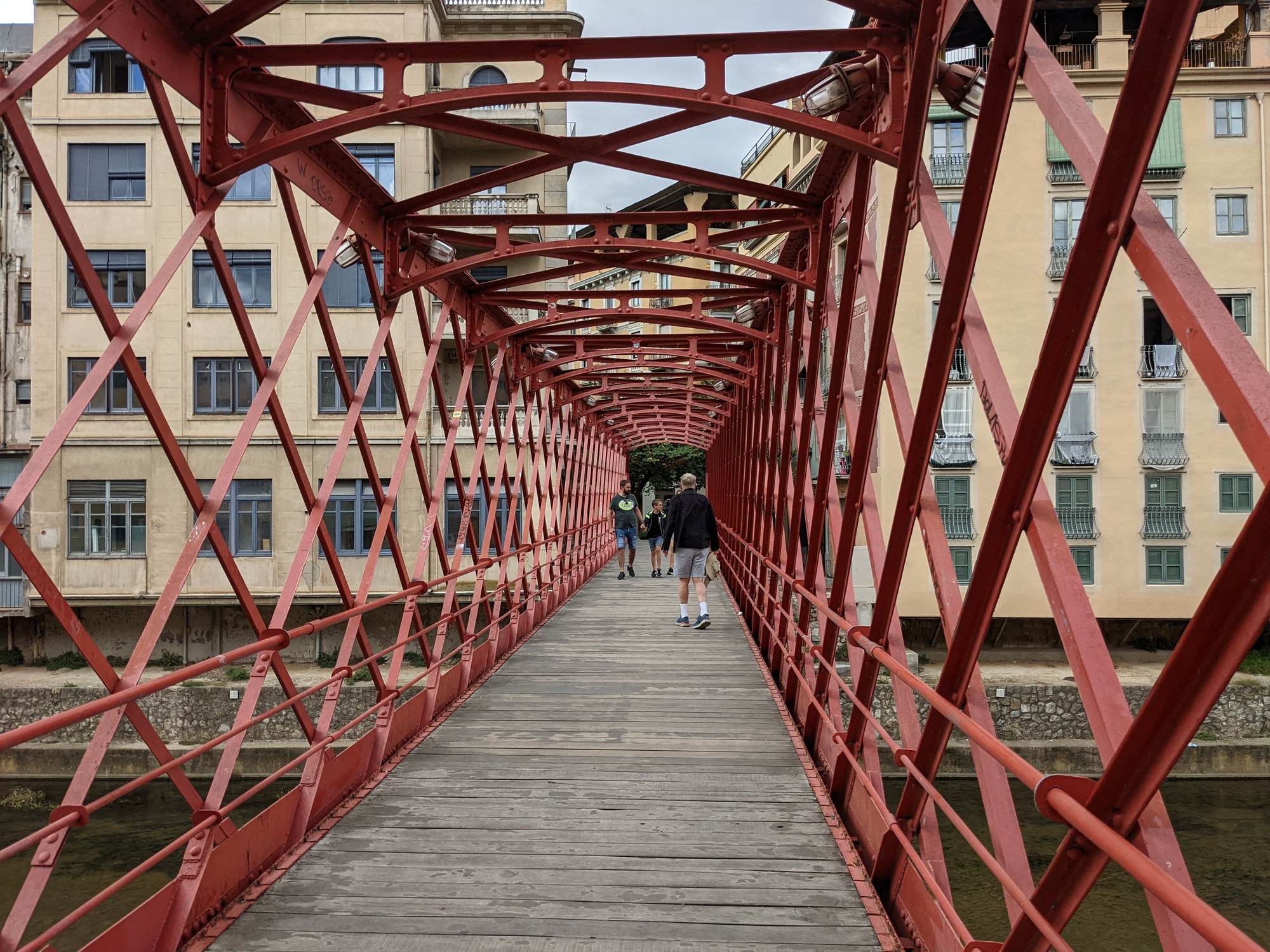
The Eiffel Bridge leading to the medieval quarter and the Rambla de la Libertat
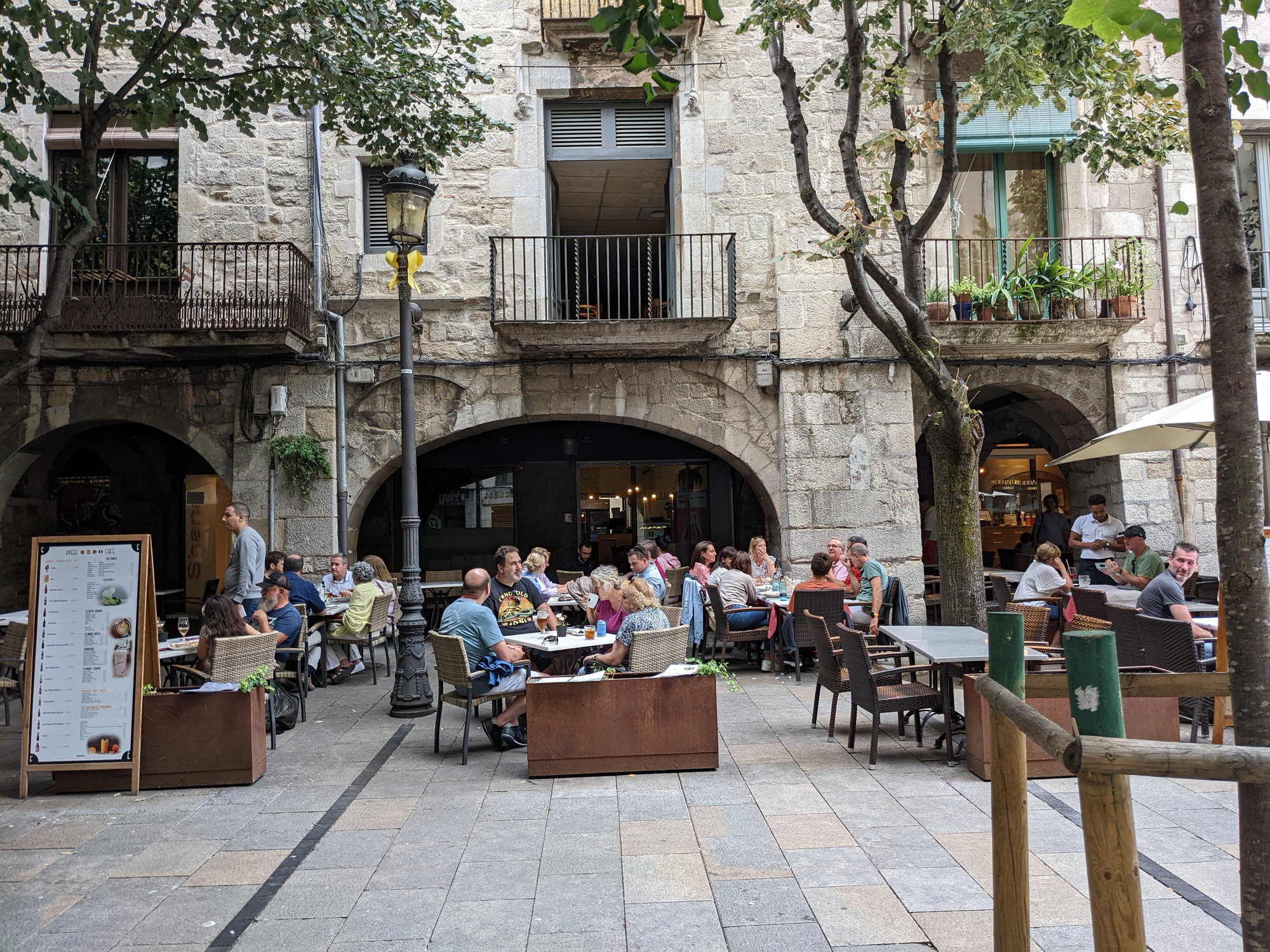

The Rambla de la Libertat
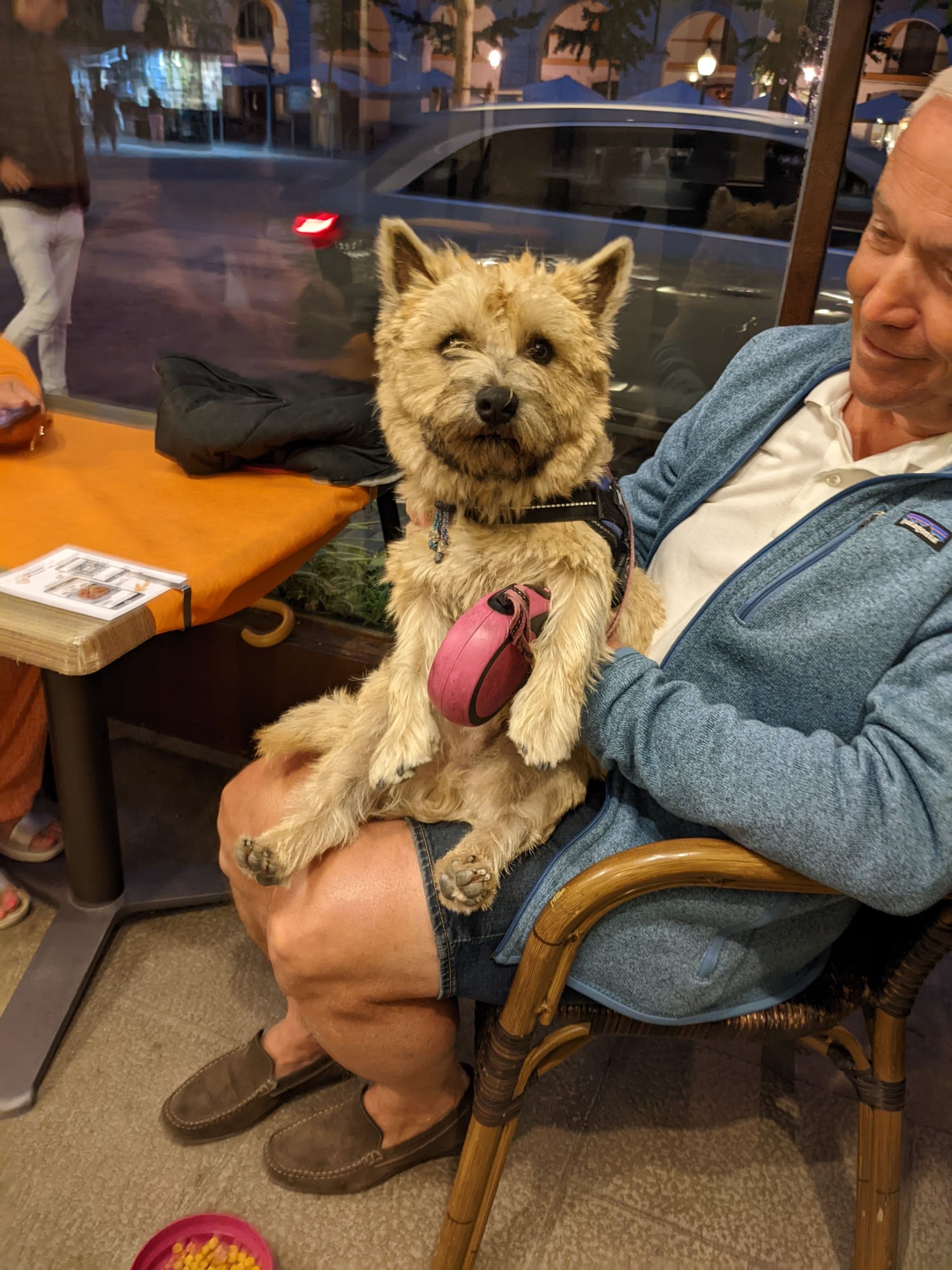
Un bonic gos catala (a handsome Catalan dog)
Coming up next: the Jewish Quarter

The Placa de la Independencia, on the west bank of the Onyar river, in the newer part of the city; cross over the Eiffel bridge and you are in medieval Girona
The river Onyar cuts through the city, north-south. The medieval part of Girona lies east of the river and is quite hilly as you walk from the river. The map below shows the growth of the city since its beginnings in pre-Roman times.

The shaded zones show different stages of the city's growth
The darkest zone is the oldest part of Girona, from pre-Roman times to about 1100 AD. The cross-hatched area is the Jewish quarter. Girona's Jewish community was one of the most important in Spain. After waves of persecution, they were expelled from Spain (or forced to convert to Catholicism) by Ferdinand and Isabella in 1492. The orange section is medieval Girona, from about 1000 to 1500 AD. The light orange area to the west of the Onyar river is the area built about 1500 to 1900 AD (in this map, "north" is on the left hand side).
The Placa de la Independencia on the west bank is lined with cafes and restaurants. Our favorite was Konig.

Konig cafe, on the Placa de la Independencia
Across the river to the east, just on the edge of the medieval area, is the Rambla de la Libertat, a beautiful street lined with arcades and cafes and restaurants, great for people and dog watching. From our hotel on the west bank, the Hotel Ciutat de Girona, we could walk across to the medieval quarter on the "Eiffel Bridge" (that's the popular tourist name; the formal name is Pont de les Peixateries Velles, the Old Fishmongers Bridge), built by Eiffel in 1876.

The Eiffel Bridge leading to the medieval quarter and the Rambla de la Libertat


The Rambla de la Libertat

Un bonic gos catala (a handsome Catalan dog)
Coming up next: the Jewish Quarter
Last edited by EYWandBTV; Oct 22nd, 2022 at 07:53 AM. Reason: correct typos
#2
Join Date: Aug 2022
Posts: 40
Likes: 0
Received 0 Likes
on
0 Posts
Actually, not only he is "a handsome Catalan dog", but -if I am not mistaken- he's a "gos d'atura" (=Catalan shepherd), a breed typical from the Catalan Pyrenees to guard and guide sheep. Alas, our local version of the Scottish Border Collie, or the Australian Cattle dog 

#5
Original Poster
Join Date: Aug 2013
Posts: 747
Likes: 0
Received 0 Likes
on
0 Posts
A few steps away from the Rambla de la Libertat is the Jewish quarter, the "Call". The photo below shows the Via Augusta, an ancient Roman highway which, centuries later, became the medieval street dividing the Jewish from the Christian neighborhoods. Until approximately the 14th century, Jews and Christians lived together throughout medieval Girona. Then Christian persecution of Jews increased and Jews were restricted to the ghetto. The Via Augusta was one boundary of the ghetto.

The ancient Via Augusta (now the Carrer de la Forca); the Cafe Augusta is on the left (not, in fact, an ancient Roman cafe...)
Another word on the Via Augusta. It was ancient Rome's "super highway" from the imperial capital in Italy, across southern France, through Girona (Roman name = Gerunda), all the way down to Cadiz on the southern Atlantic coast.
Many of the buildings in the Call have courtyards for carriages, horses, etc. Here, below, is our excellent guide, Mireia (Catalan for Maria). We arranged for a guided tour with Mireia in Spanish, the only possibility, and we stumbled through our broken Spanish in the beginning of our tour but it turned out Mireia spoke English much much better than we spoke Spanish, so we had a very understandable visit!

A courtyard in the Jewish quarter
After decades of increasing persecution, Ferdinand and Isabella exiled all Jews from Spain in 1492 (unless they converted to Catholicism). The history of the Jewish community in this neighborhood was wiped out. During the Franco dictatorship (ally of Hitler and Mussolini), the government even blocked up some of the narrow streets of the Call. As an indication of the deep antisemitism of some (not all) of Spain, it was illegal to perform Jewish ceremonies publicly in Spain until 1960! Little by little, after the death of Franco in 1975, Catalonia regained some autonomy, and the Catalan government, historians, and archeologists recovered this important part of Girona's history. Signs of the former Jewish community still survive--the mezuzzah niches, for example.

Our guide points out a niche for a mezuzzah by a doorway in the medieval Jewish quarter.
A mezuzzah was a small scroll with the sacred words of the Torah "Hear O Israel the Lord is our God, the Lord is One". The scroll was placed in a doorway niche, and one touched the mezuzzah on entering or leaving the house.
Because space was so tight in the Jewish quarter, houses increased in size and also were extended over the narrow streets, creating little tunnels throughout the quarter.


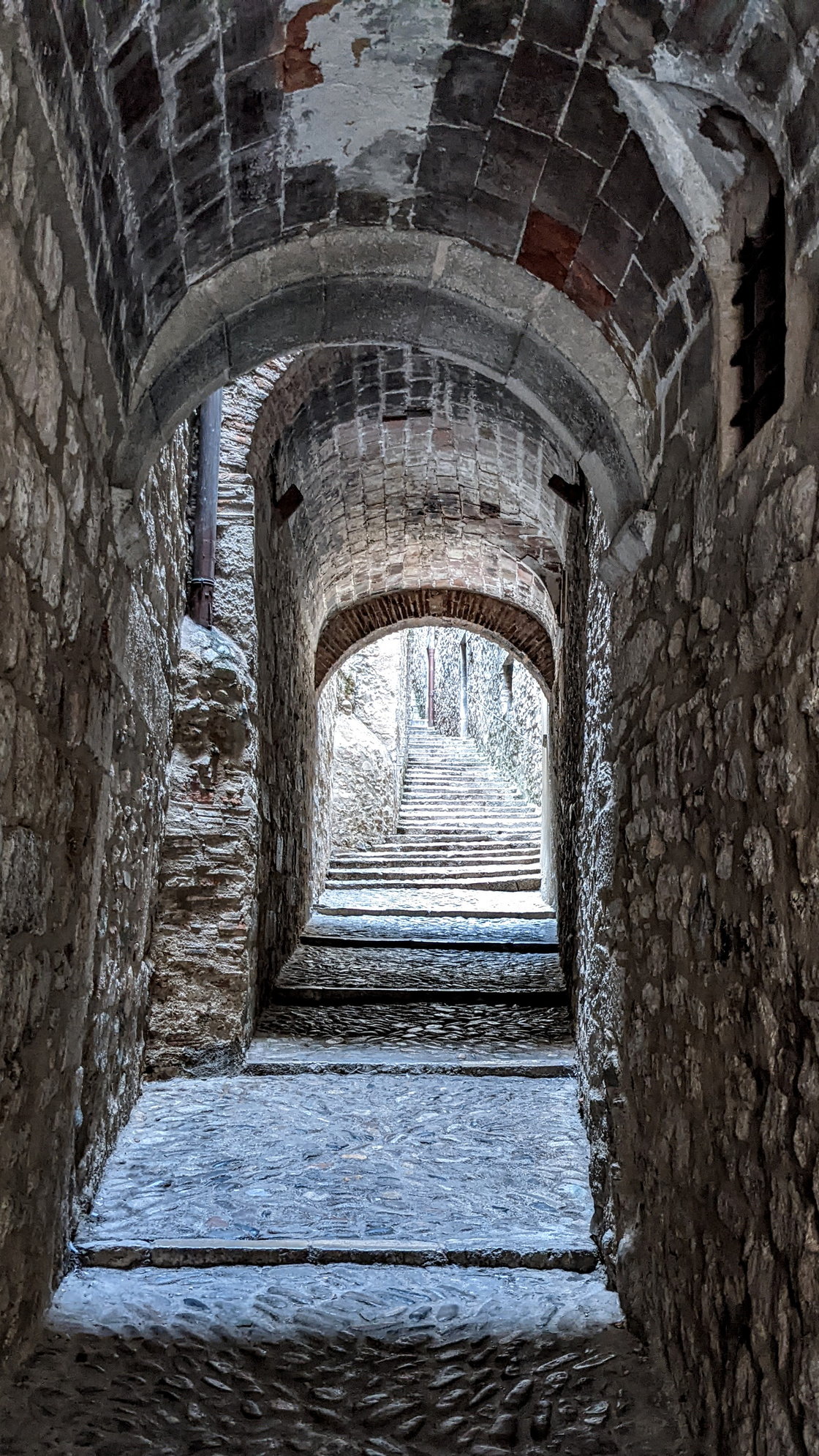
Narrow lanes in the Jewish quarter
These stairs (below) were cut through the Jewish quarter to lead up to the statue of the Virgin Mary. The remains of the synagogue are on the right.
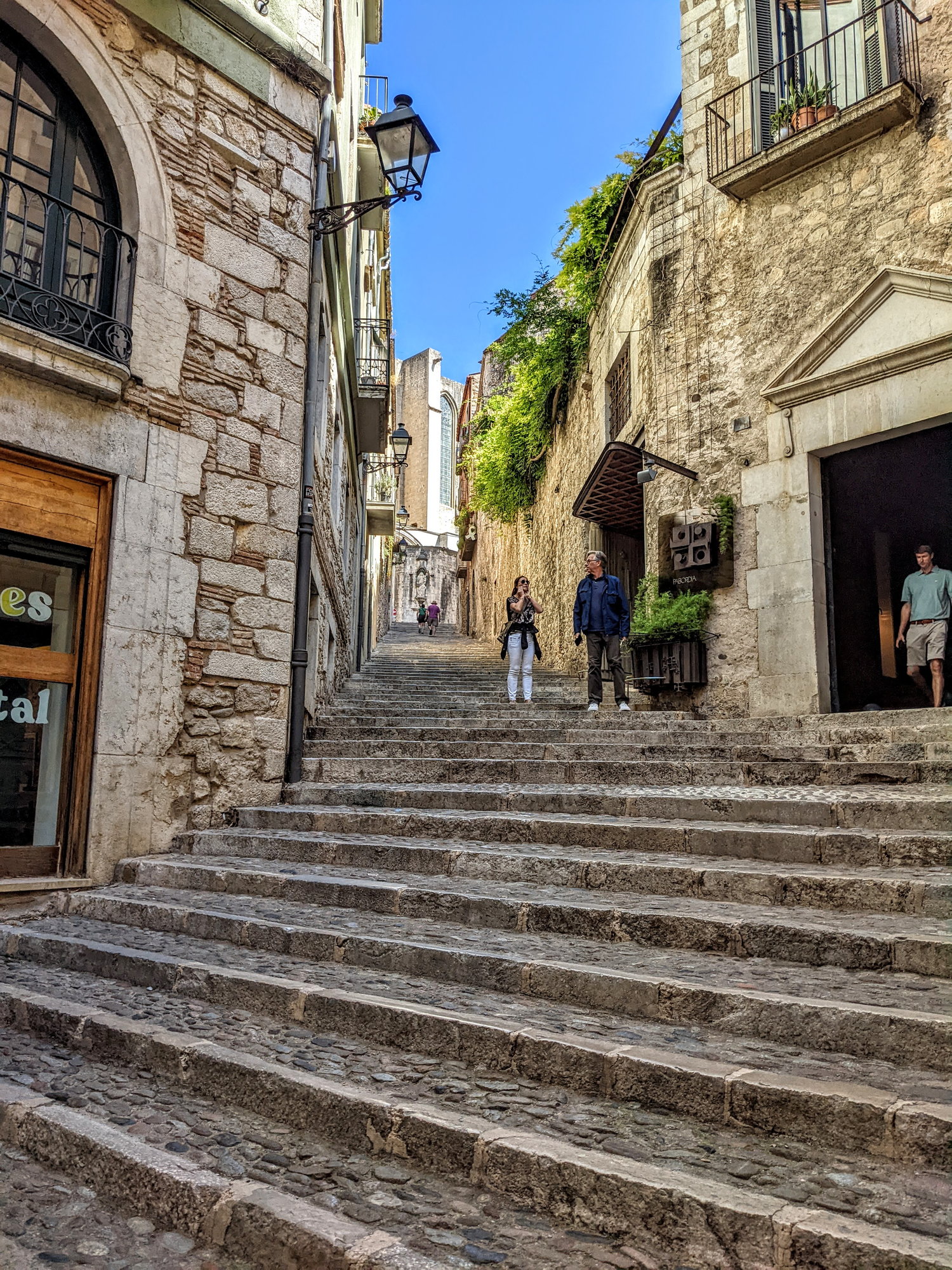
The remains of the synagogue are to the right of the staircase; the shrine of the Virgin Mary is at the very top of the stairs
A great repository of the history of the Jewish community in Girona is the Museum of Jewish History, created in the last few decades inside the structure of the medieval synagogue.

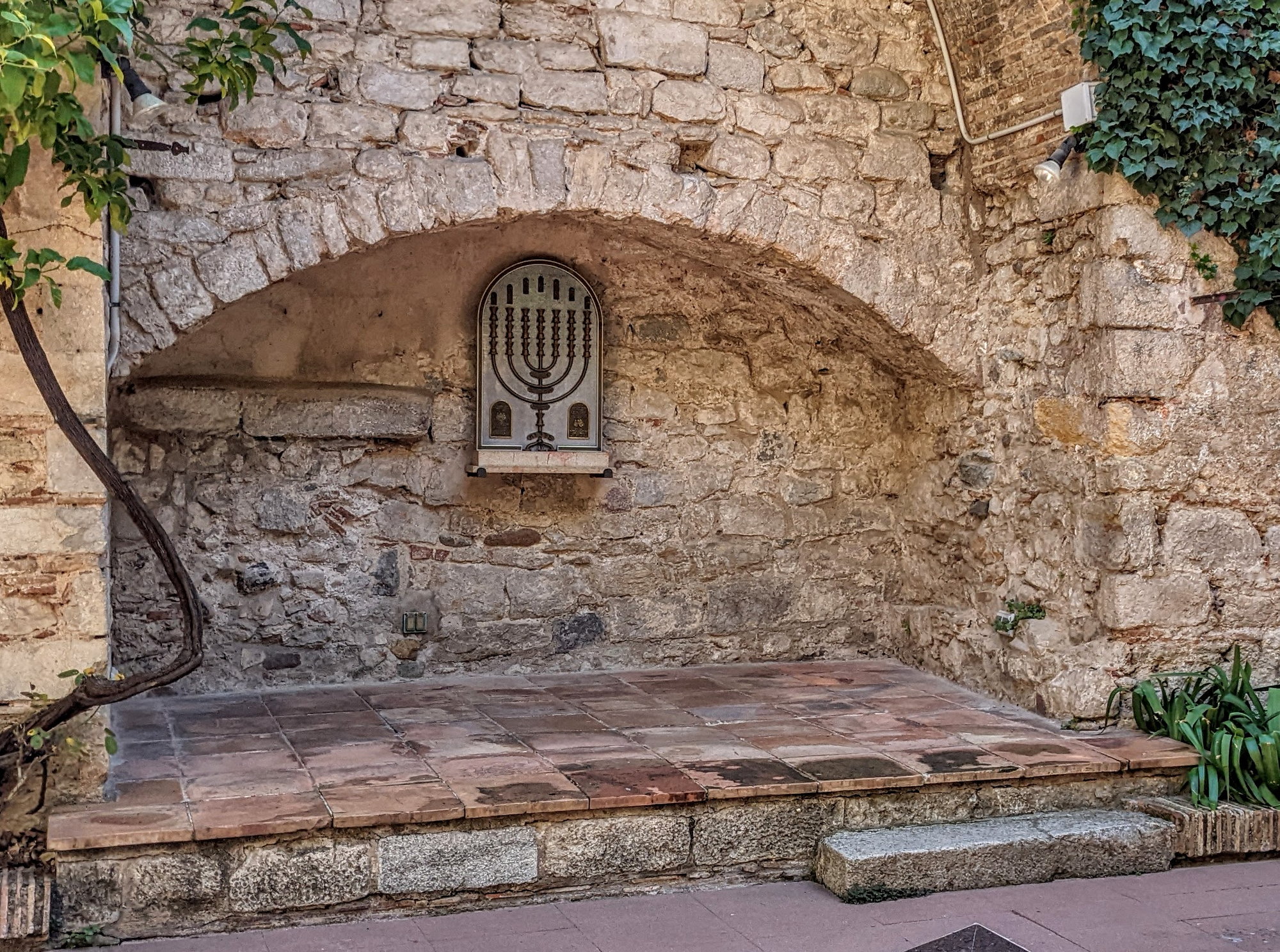
After democracy was restored in Spain following Franco's death, archeologists uncovered and restored much of the Jewish quarter, including the synagogue itself. The original mikveh was discovered; this was the immersion bath for purification.
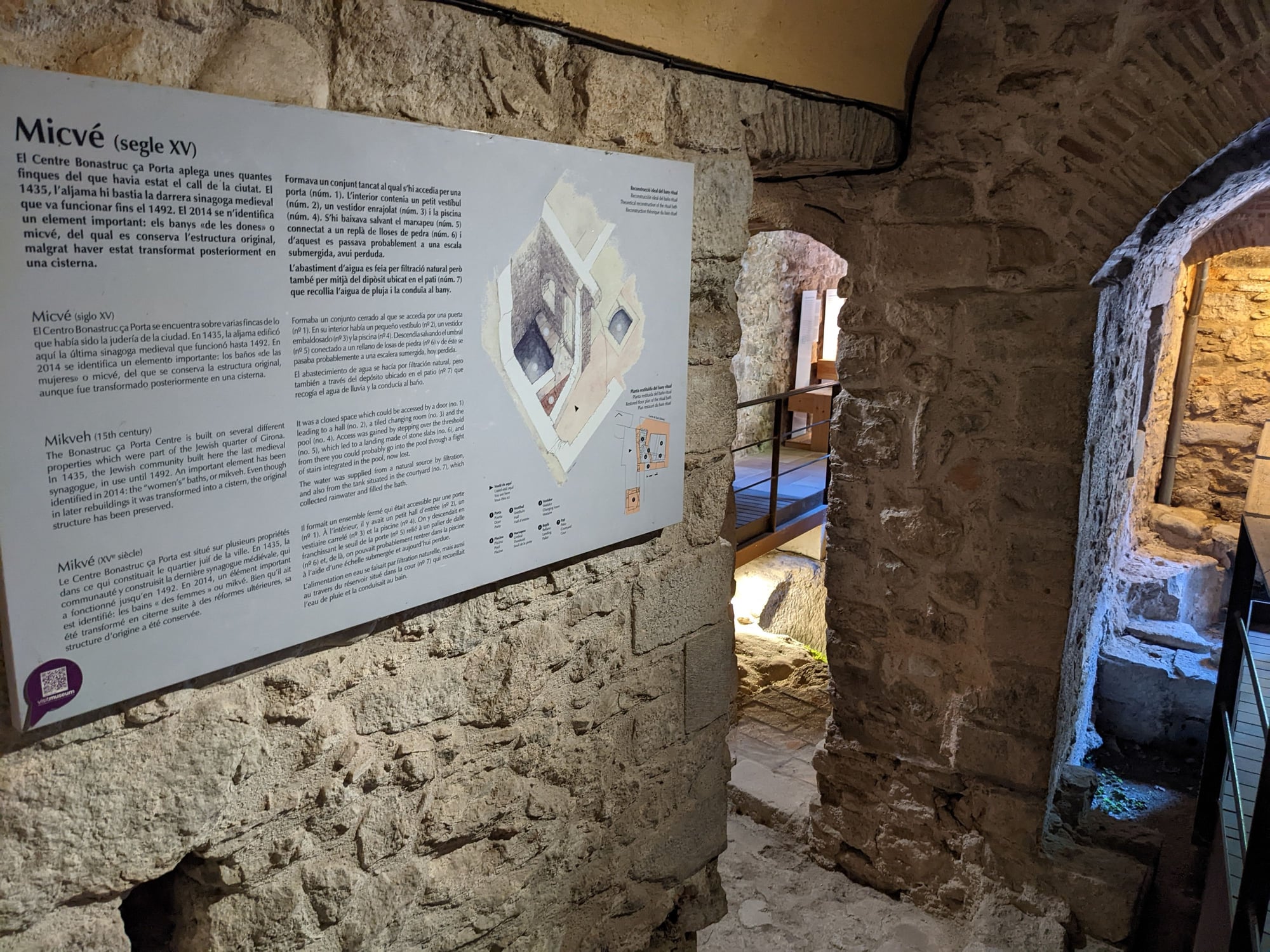
The mikveh in the synagogue
After visiting the museum, we walked over to the great Girona cathedral.

The ancient Via Augusta (now the Carrer de la Forca); the Cafe Augusta is on the left (not, in fact, an ancient Roman cafe...)
Another word on the Via Augusta. It was ancient Rome's "super highway" from the imperial capital in Italy, across southern France, through Girona (Roman name = Gerunda), all the way down to Cadiz on the southern Atlantic coast.
Many of the buildings in the Call have courtyards for carriages, horses, etc. Here, below, is our excellent guide, Mireia (Catalan for Maria). We arranged for a guided tour with Mireia in Spanish, the only possibility, and we stumbled through our broken Spanish in the beginning of our tour but it turned out Mireia spoke English much much better than we spoke Spanish, so we had a very understandable visit!

A courtyard in the Jewish quarter
After decades of increasing persecution, Ferdinand and Isabella exiled all Jews from Spain in 1492 (unless they converted to Catholicism). The history of the Jewish community in this neighborhood was wiped out. During the Franco dictatorship (ally of Hitler and Mussolini), the government even blocked up some of the narrow streets of the Call. As an indication of the deep antisemitism of some (not all) of Spain, it was illegal to perform Jewish ceremonies publicly in Spain until 1960! Little by little, after the death of Franco in 1975, Catalonia regained some autonomy, and the Catalan government, historians, and archeologists recovered this important part of Girona's history. Signs of the former Jewish community still survive--the mezuzzah niches, for example.

Our guide points out a niche for a mezuzzah by a doorway in the medieval Jewish quarter.
A mezuzzah was a small scroll with the sacred words of the Torah "Hear O Israel the Lord is our God, the Lord is One". The scroll was placed in a doorway niche, and one touched the mezuzzah on entering or leaving the house.
Because space was so tight in the Jewish quarter, houses increased in size and also were extended over the narrow streets, creating little tunnels throughout the quarter.



Narrow lanes in the Jewish quarter
These stairs (below) were cut through the Jewish quarter to lead up to the statue of the Virgin Mary. The remains of the synagogue are on the right.

The remains of the synagogue are to the right of the staircase; the shrine of the Virgin Mary is at the very top of the stairs
A great repository of the history of the Jewish community in Girona is the Museum of Jewish History, created in the last few decades inside the structure of the medieval synagogue.


After democracy was restored in Spain following Franco's death, archeologists uncovered and restored much of the Jewish quarter, including the synagogue itself. The original mikveh was discovered; this was the immersion bath for purification.

The mikveh in the synagogue
After visiting the museum, we walked over to the great Girona cathedral.
#6
Original Poster
Join Date: Aug 2013
Posts: 747
Likes: 0
Received 0 Likes
on
0 Posts
Onward to the cathedral...passing by remnants of the Roman walls in the medieval quarter...

The cathedral looms over a flight of 90 steps, an impressive sight. We read that this is a perfect example of Catalan Gothic--imposing, austere, massive, with one rose window in the facade.
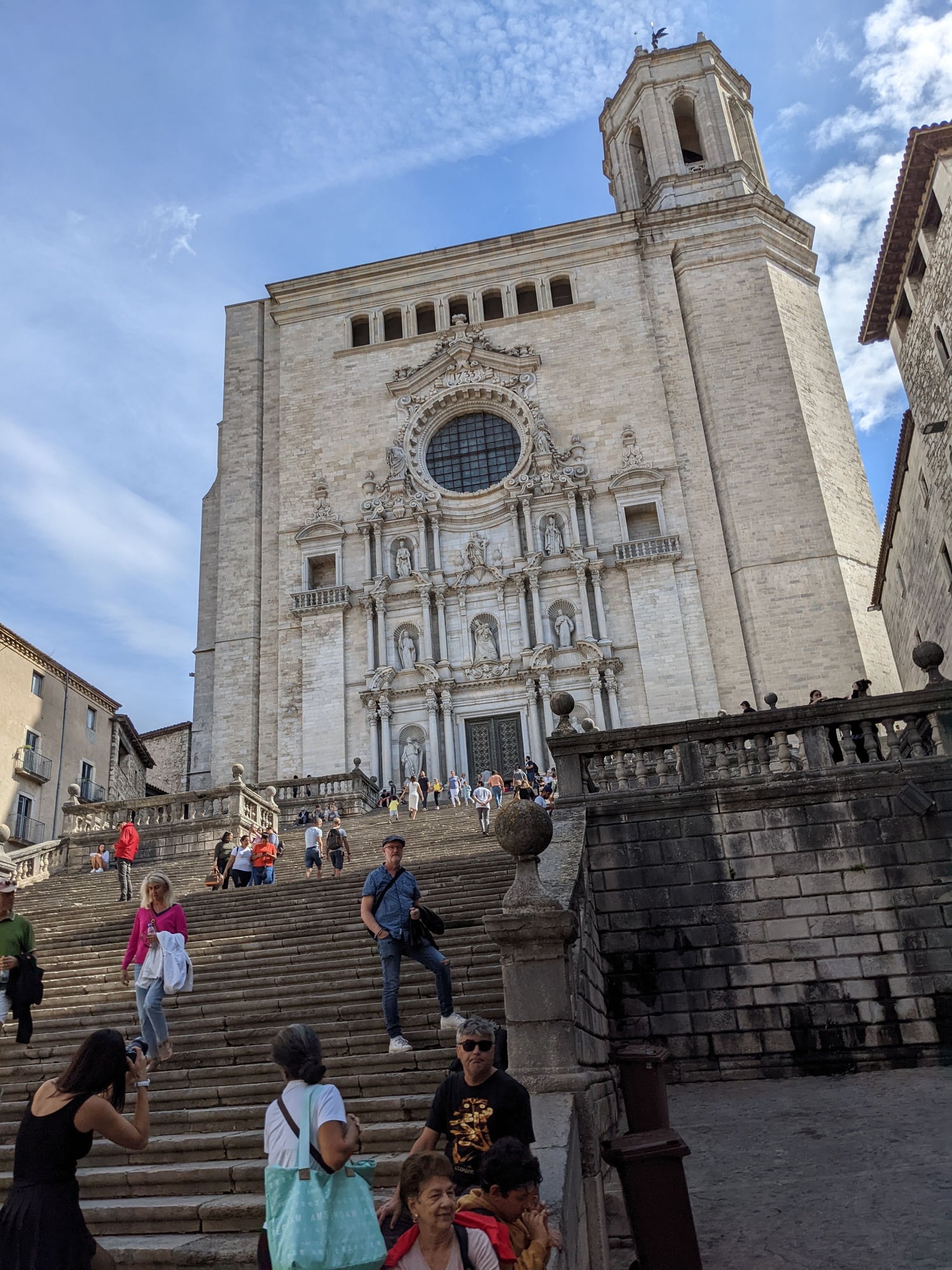
It is the interior which astonishes: the nave is the widest of all Gothic churches, twice the width of Notre Dame de Paris! You feel, on entering, the rush of an enormous space....
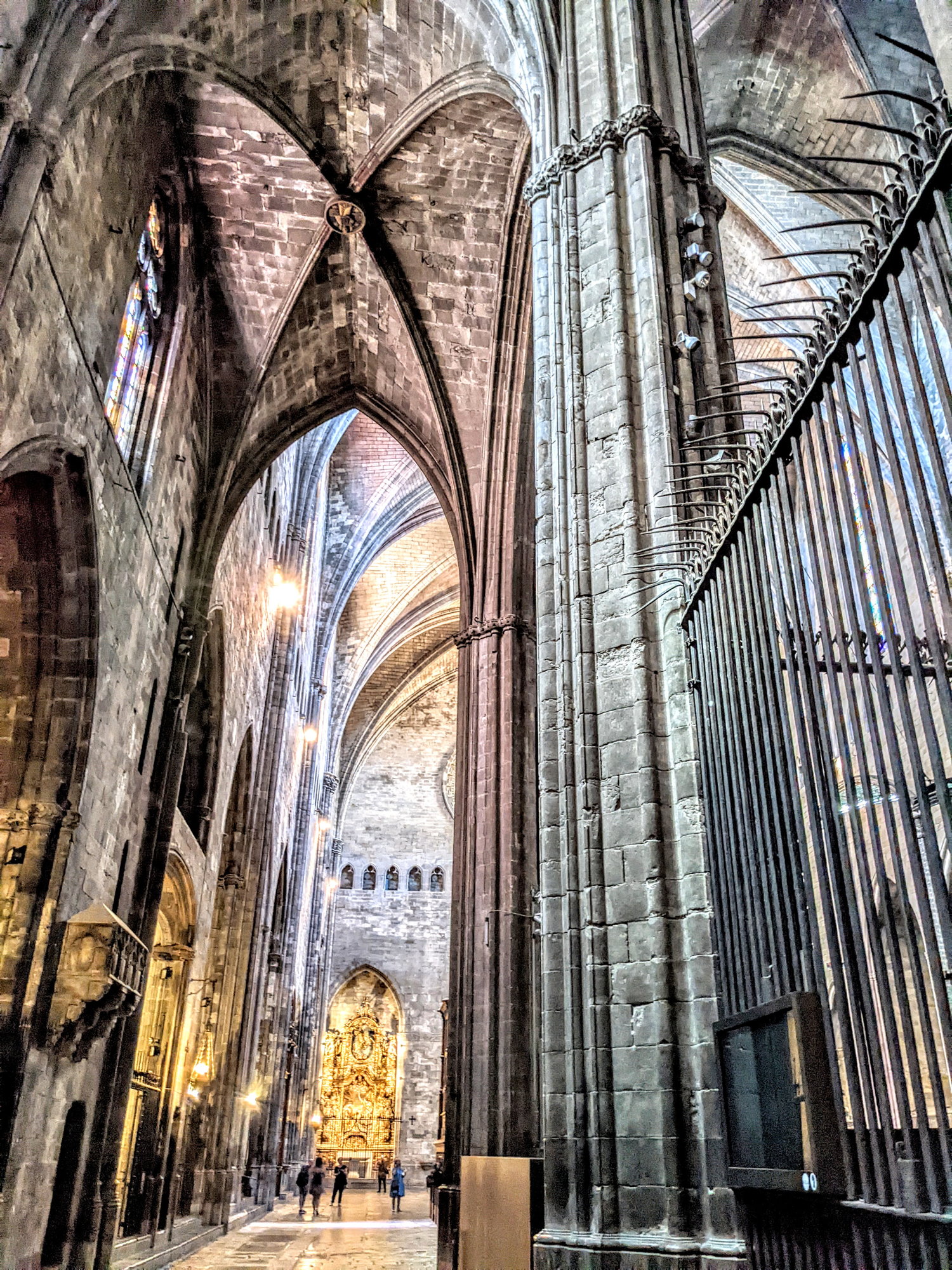
For a sense of the vastness of the space, look at the tiny figures of visitors at the very bottom left of the photo
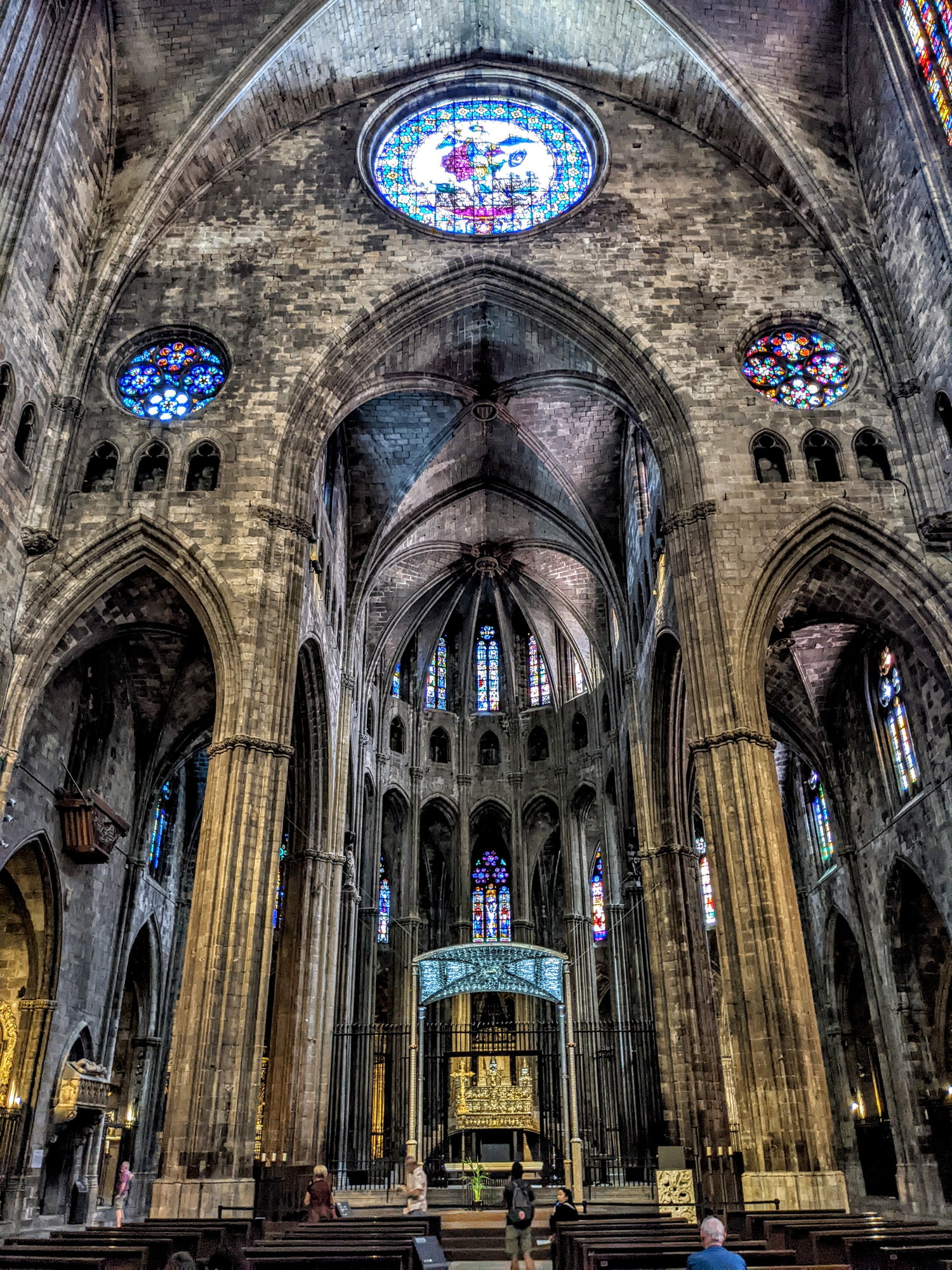
The high altar and the apse
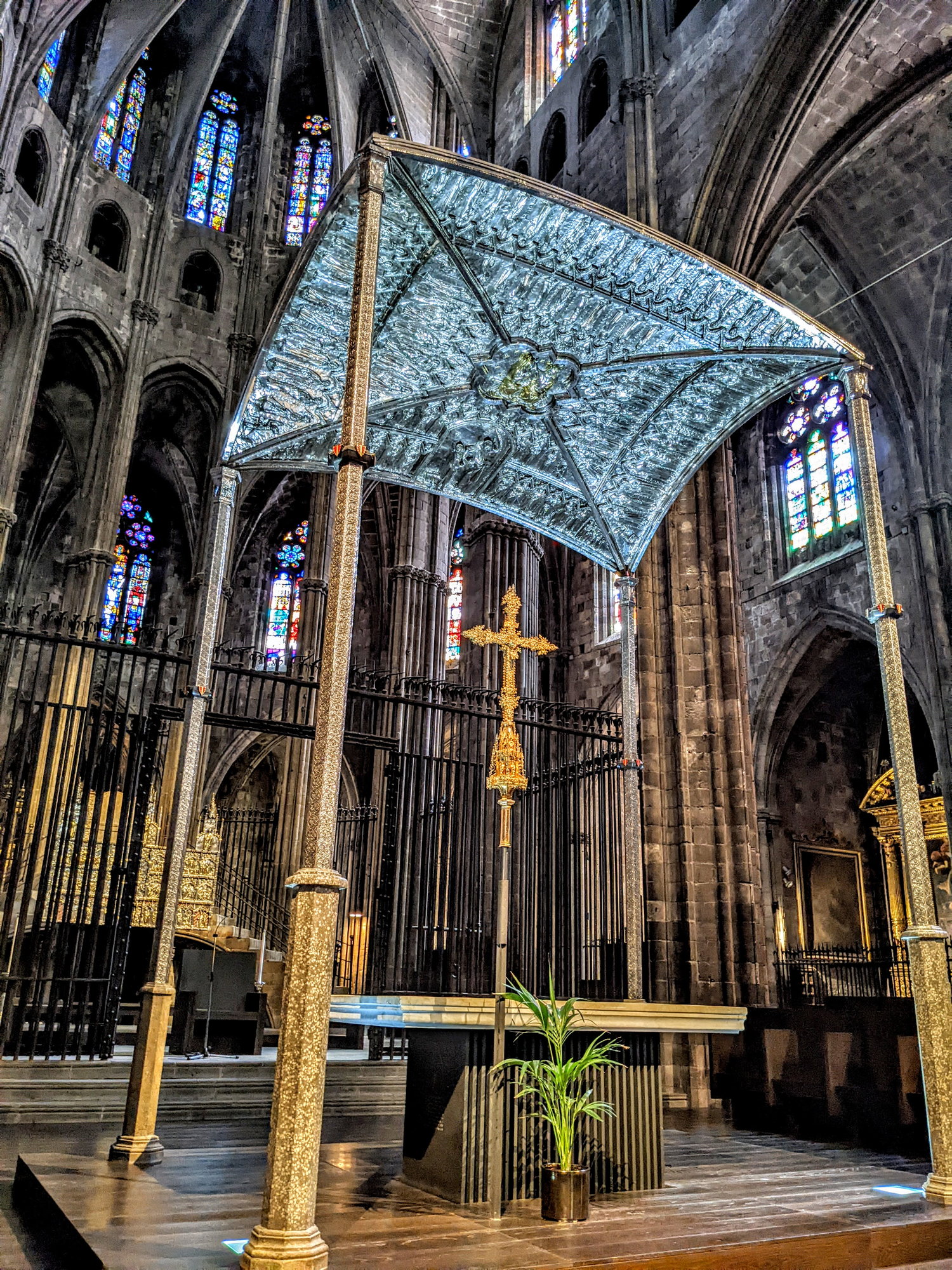
The silver canopy, or baldachin, over the high altar
From the cathedral we walked outside to the cloister, with its wonderful Romanesque capitals...
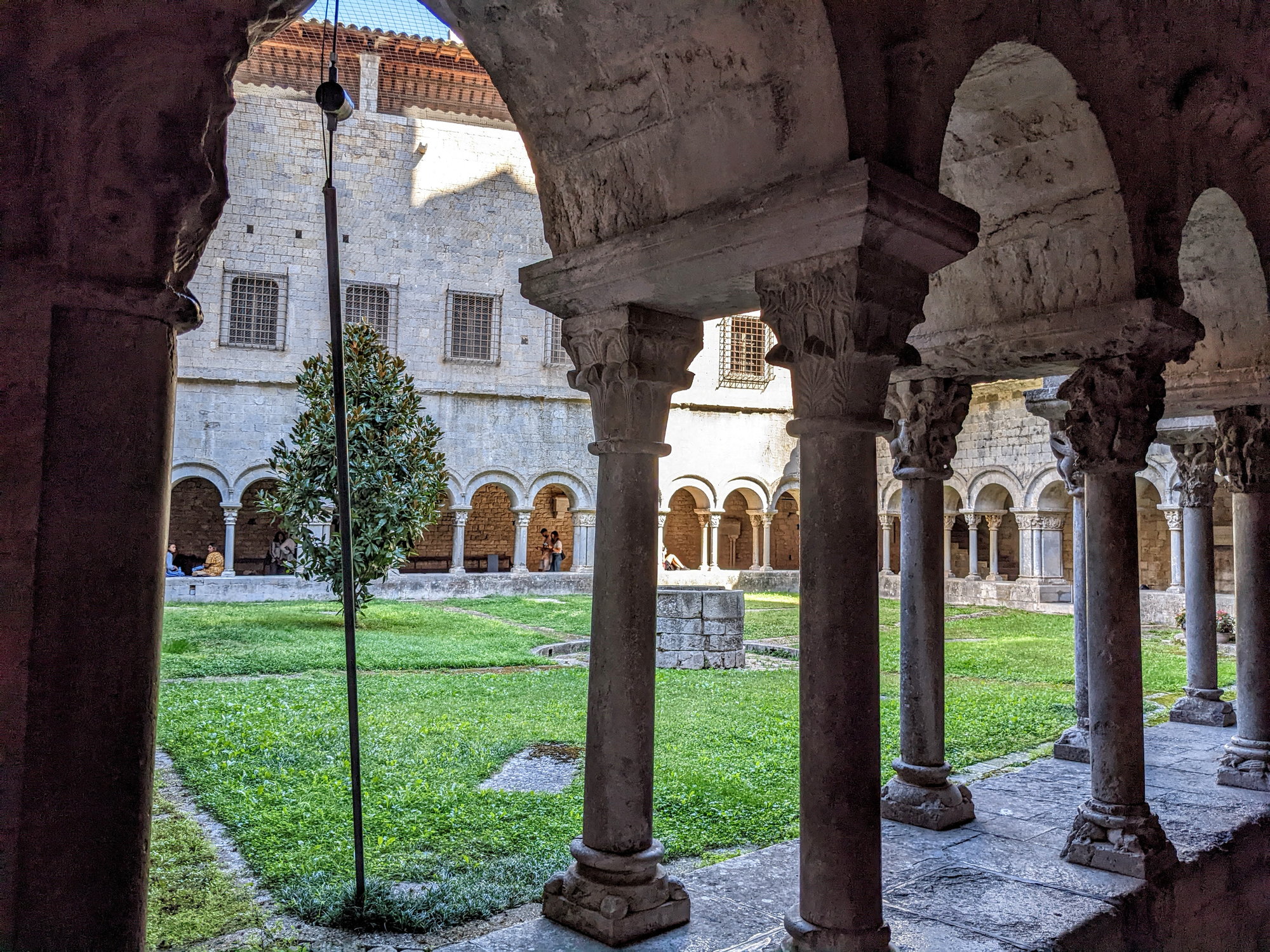
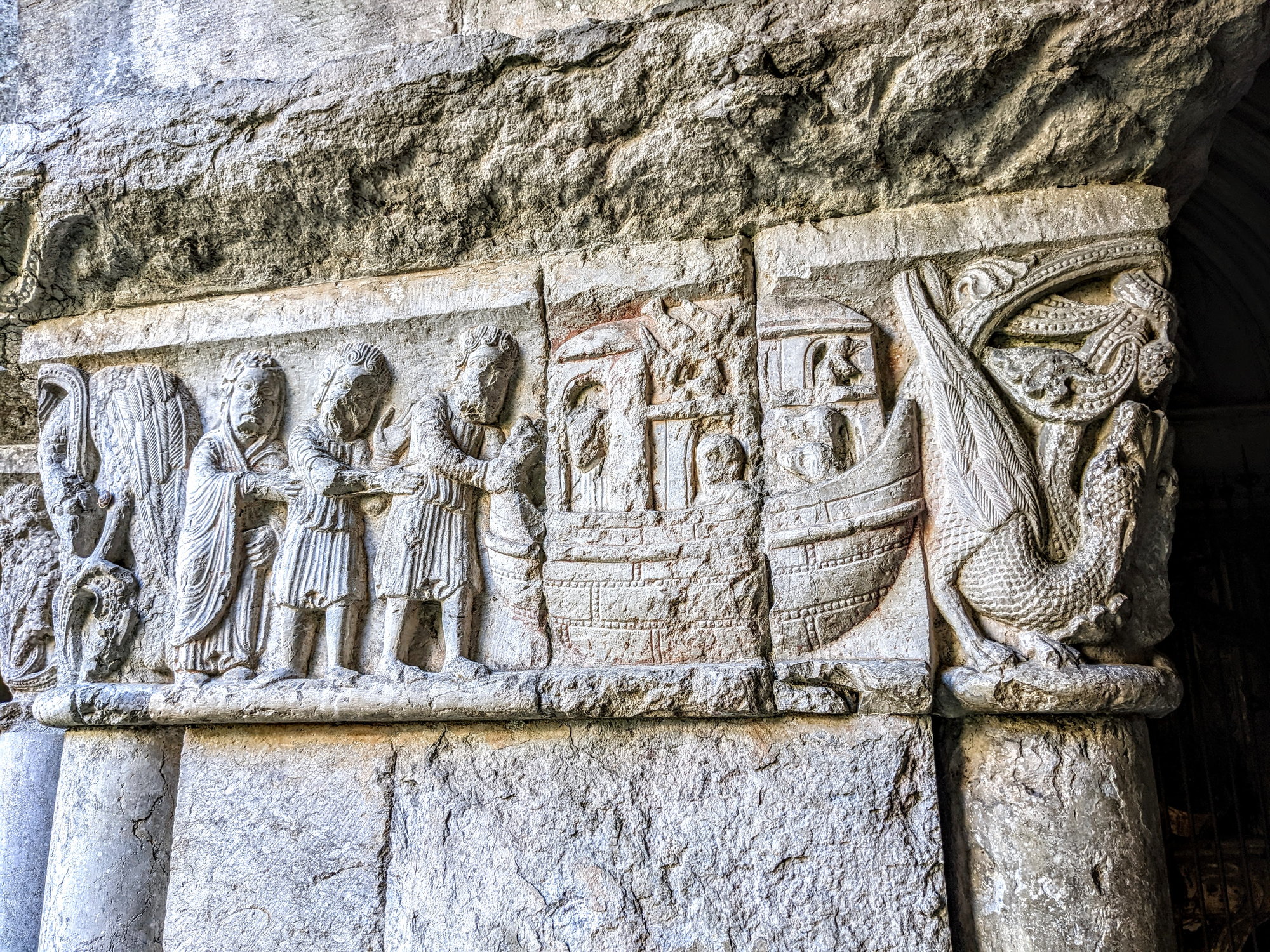
Noah and the Ark
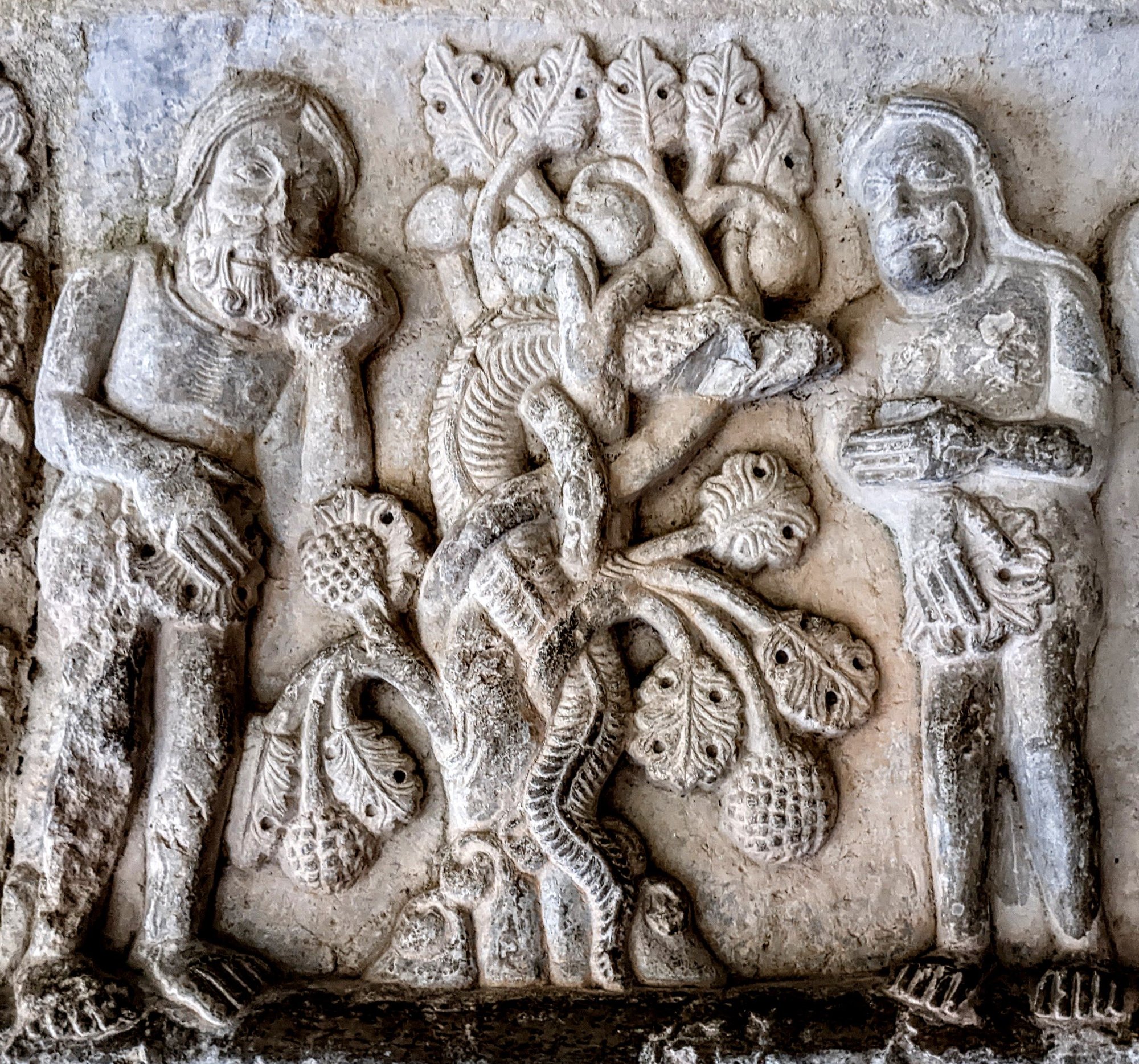
Adam and Eve
From the cloister we entered the cathedral museum, full of treasures, the greatest of which is the Tapestry of the Creation of the World.

The tapestry is considered one of the most important and ancient textile pieces of Christian Europe, dating perhaps back to the 11th century. It presents the medieval world view: Christ as the mighty Creator in the center...
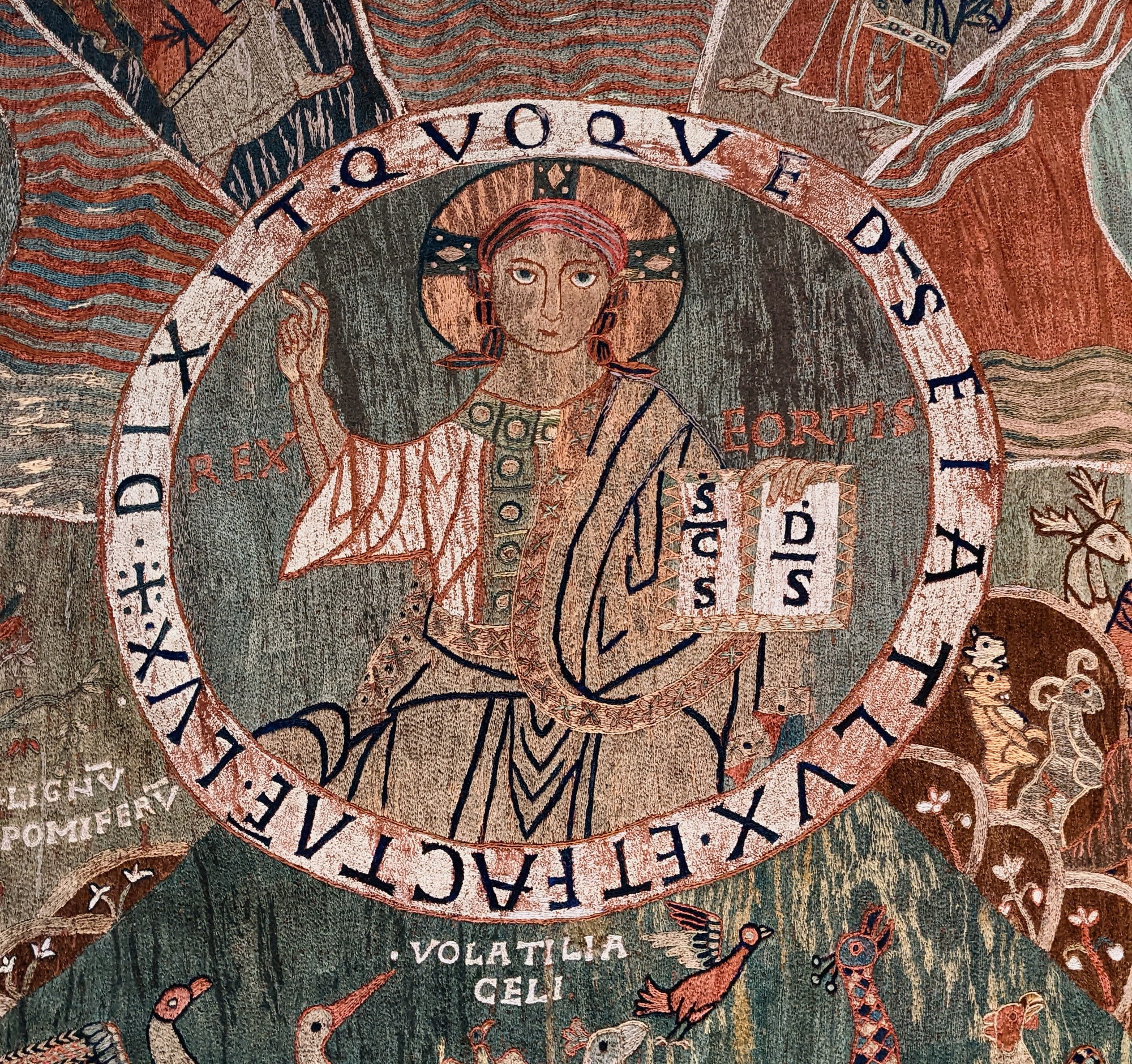
Christ is surrounded by depictions of the days of creation, the seasons, the sun and moon, the four rivers of paradise, and other images. Considering the fact that the tapestry (made of dyed wool) is 1,000 years old, the colors and designs are surprisingly sharp.

The cathedral looms over a flight of 90 steps, an impressive sight. We read that this is a perfect example of Catalan Gothic--imposing, austere, massive, with one rose window in the facade.

It is the interior which astonishes: the nave is the widest of all Gothic churches, twice the width of Notre Dame de Paris! You feel, on entering, the rush of an enormous space....

For a sense of the vastness of the space, look at the tiny figures of visitors at the very bottom left of the photo

The high altar and the apse

The silver canopy, or baldachin, over the high altar
From the cathedral we walked outside to the cloister, with its wonderful Romanesque capitals...


Noah and the Ark

Adam and Eve
From the cloister we entered the cathedral museum, full of treasures, the greatest of which is the Tapestry of the Creation of the World.

The tapestry is considered one of the most important and ancient textile pieces of Christian Europe, dating perhaps back to the 11th century. It presents the medieval world view: Christ as the mighty Creator in the center...

Christ is surrounded by depictions of the days of creation, the seasons, the sun and moon, the four rivers of paradise, and other images. Considering the fact that the tapestry (made of dyed wool) is 1,000 years old, the colors and designs are surprisingly sharp.
#11
Original Poster
Join Date: Aug 2013
Posts: 747
Likes: 0
Received 0 Likes
on
0 Posts
After visiting the cathedral, I walked over to the Jardins dels Alemanys, the Gardens of the Germans. This was the site of the barracks of Central European (the "Germans") mercenary troops defending the city in the late 17th century. Today it is a pleasant, peaceful park nestled up against the medieval walls which surround the old city.
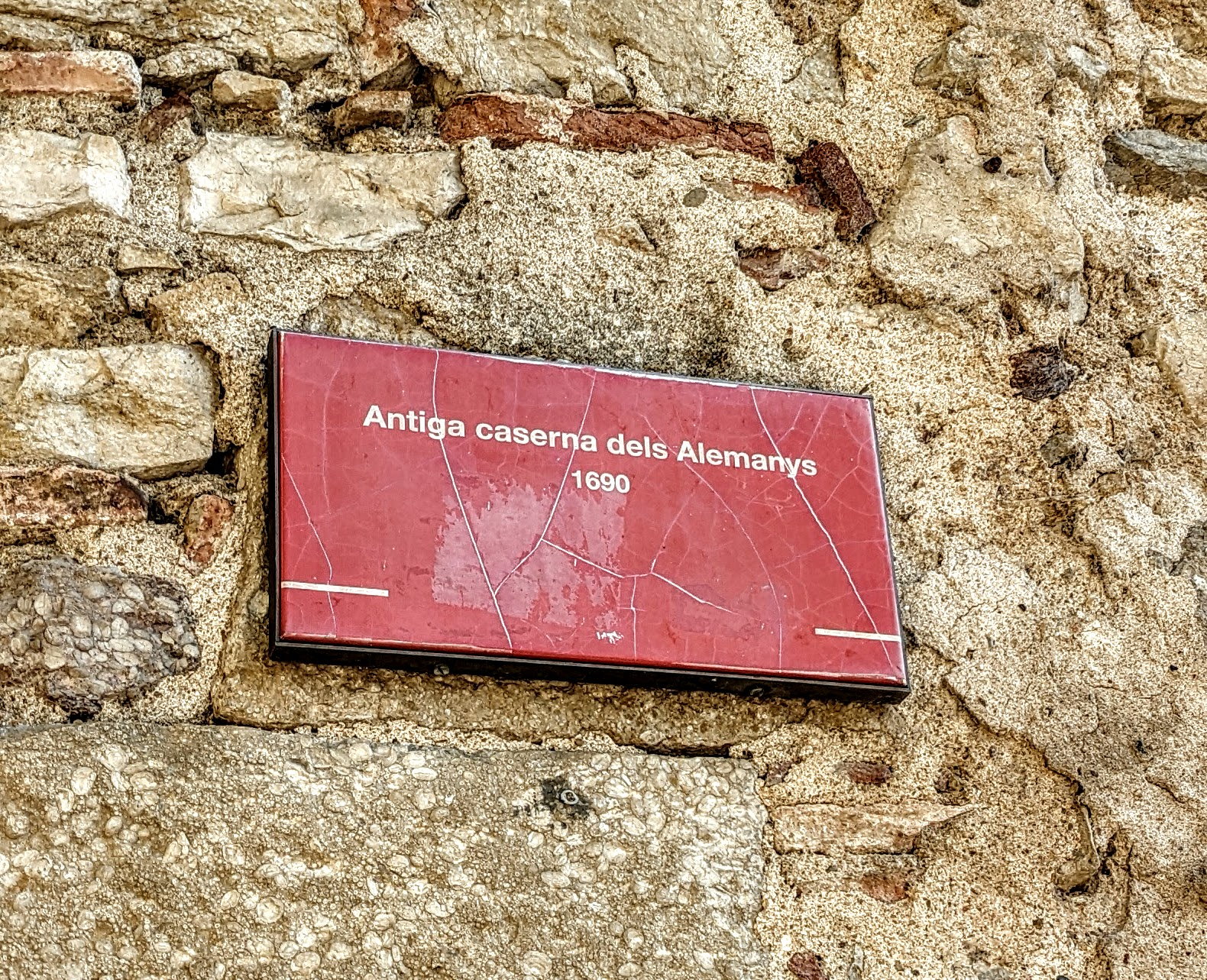
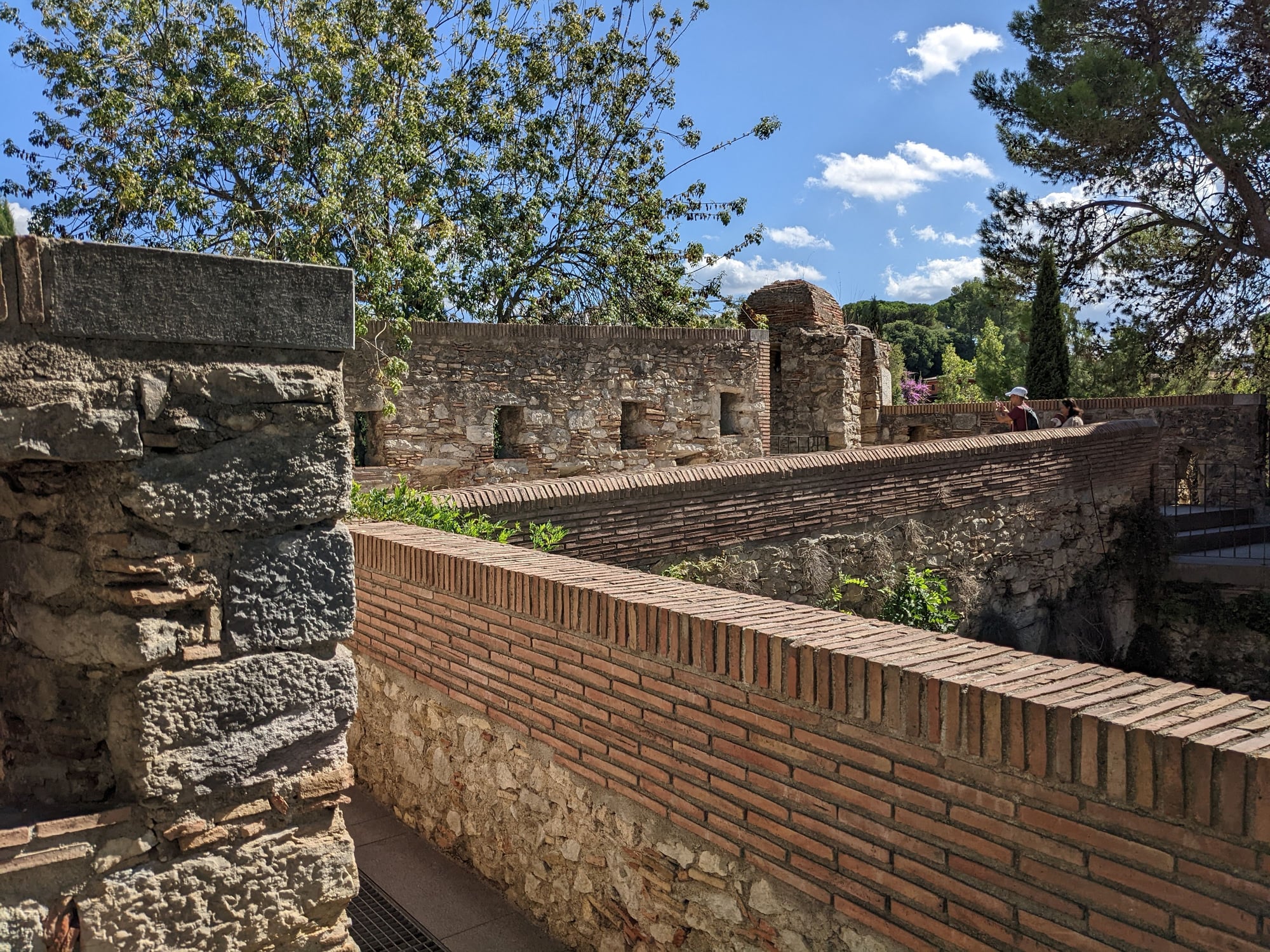
Part of the medieval walls (a restored section is on the right); this is just a small part of the extensive, surviving medieval walls
The Gironella Tower is part of the walls bordering the gardens. The tower is ancient; there is some evidence that the base may even go back before Roman times. The tower has a tragic past: in 1391, as the plague tore through Girona, Christian mobs descended on the Jewish quarter, blaming them for the plague and massacring many of the inhabitants. Some Jews sought refuge in this tower, where they survived for weeks. (In medieval Spain, Jews were under the protection of the king, who valued their financial services since the Church forbade lending money; this royal protection was not always effective, however.)
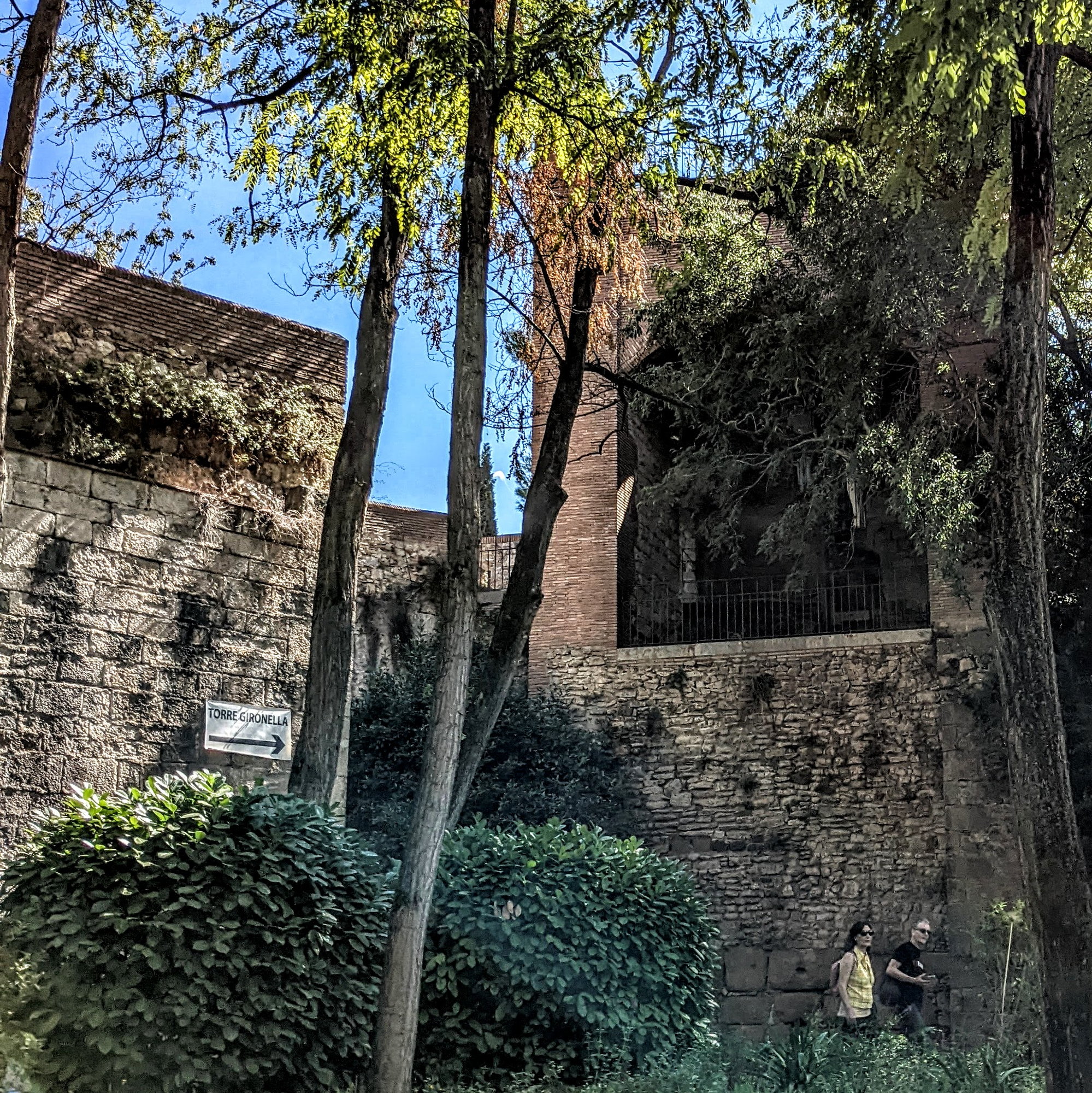
Entrance to the Gironella Tower (hard to see the details because of the trees)
After going up to the tower and relaxing in the gardens, I wandered again through the back streets of the medieval quarter. Catalan flags were everywhere....
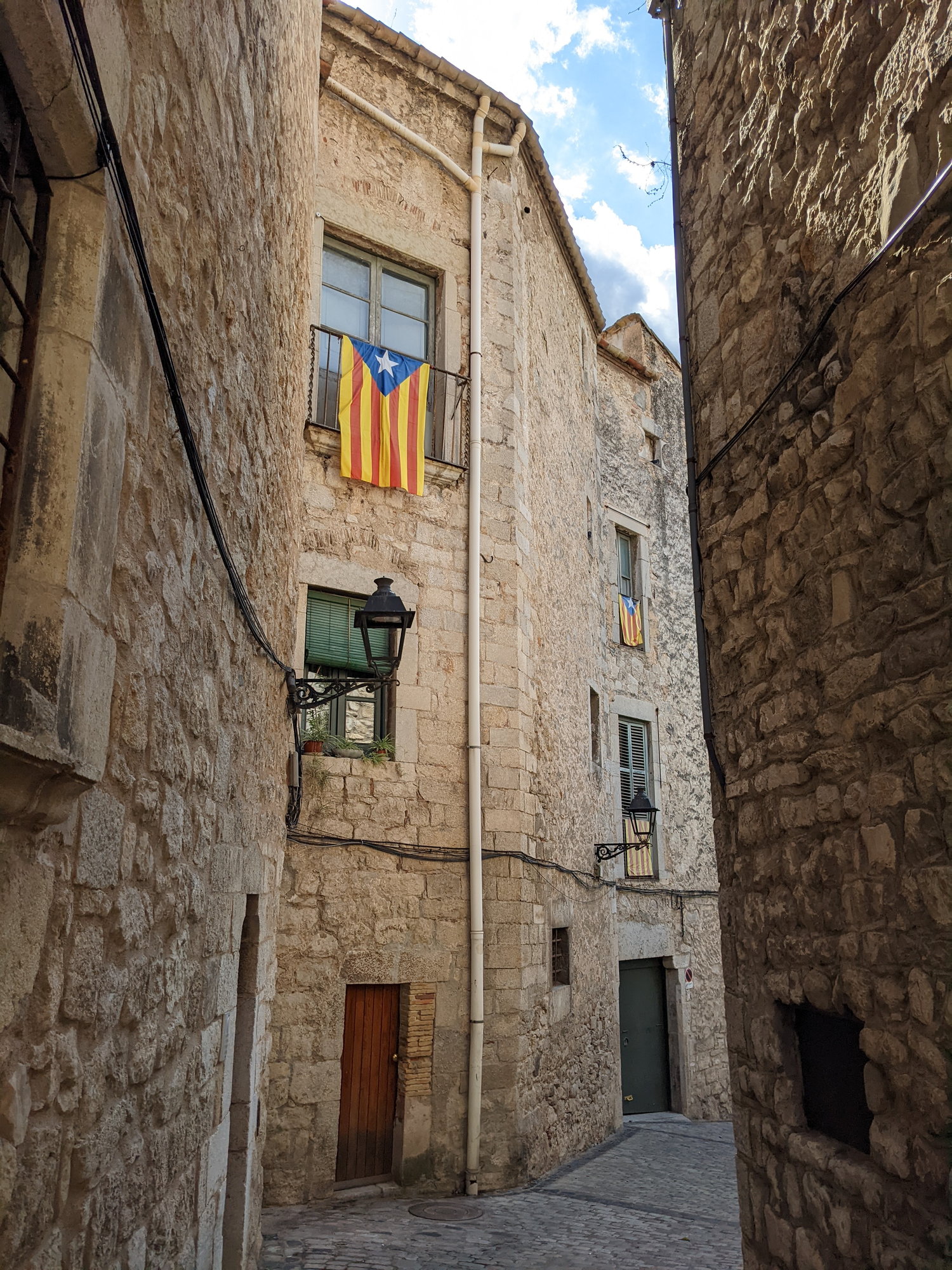
Flags of Catalonia in the old town
...as well as banners demanding "freedom for political prisoners". This refers to Madrid's trial and imprisonment of the leaders of Catalonia's independence referendum in 2017. Girona seems to be in the heartland of Catalan identity; our guide Mireia told us that it is one of the cities where Catalan is most spoken. As foreign visitors we listened attentively but obviously kept our mouths shut about this sensitive and complex subject!


Part of the medieval walls (a restored section is on the right); this is just a small part of the extensive, surviving medieval walls
The Gironella Tower is part of the walls bordering the gardens. The tower is ancient; there is some evidence that the base may even go back before Roman times. The tower has a tragic past: in 1391, as the plague tore through Girona, Christian mobs descended on the Jewish quarter, blaming them for the plague and massacring many of the inhabitants. Some Jews sought refuge in this tower, where they survived for weeks. (In medieval Spain, Jews were under the protection of the king, who valued their financial services since the Church forbade lending money; this royal protection was not always effective, however.)

Entrance to the Gironella Tower (hard to see the details because of the trees)
After going up to the tower and relaxing in the gardens, I wandered again through the back streets of the medieval quarter. Catalan flags were everywhere....

Flags of Catalonia in the old town
...as well as banners demanding "freedom for political prisoners". This refers to Madrid's trial and imprisonment of the leaders of Catalonia's independence referendum in 2017. Girona seems to be in the heartland of Catalan identity; our guide Mireia told us that it is one of the cities where Catalan is most spoken. As foreign visitors we listened attentively but obviously kept our mouths shut about this sensitive and complex subject!
#19
Original Poster
Join Date: Aug 2013
Posts: 747
Likes: 0
Received 0 Likes
on
0 Posts
Next, the 12th century church and cloister of the Benedictine monastery, Sant Pere des Galligants (Galligants is the nearby river). The church is similar in style to the cathedral: the facade is austere with a single large rose window. The interior is hardy Romanesque.
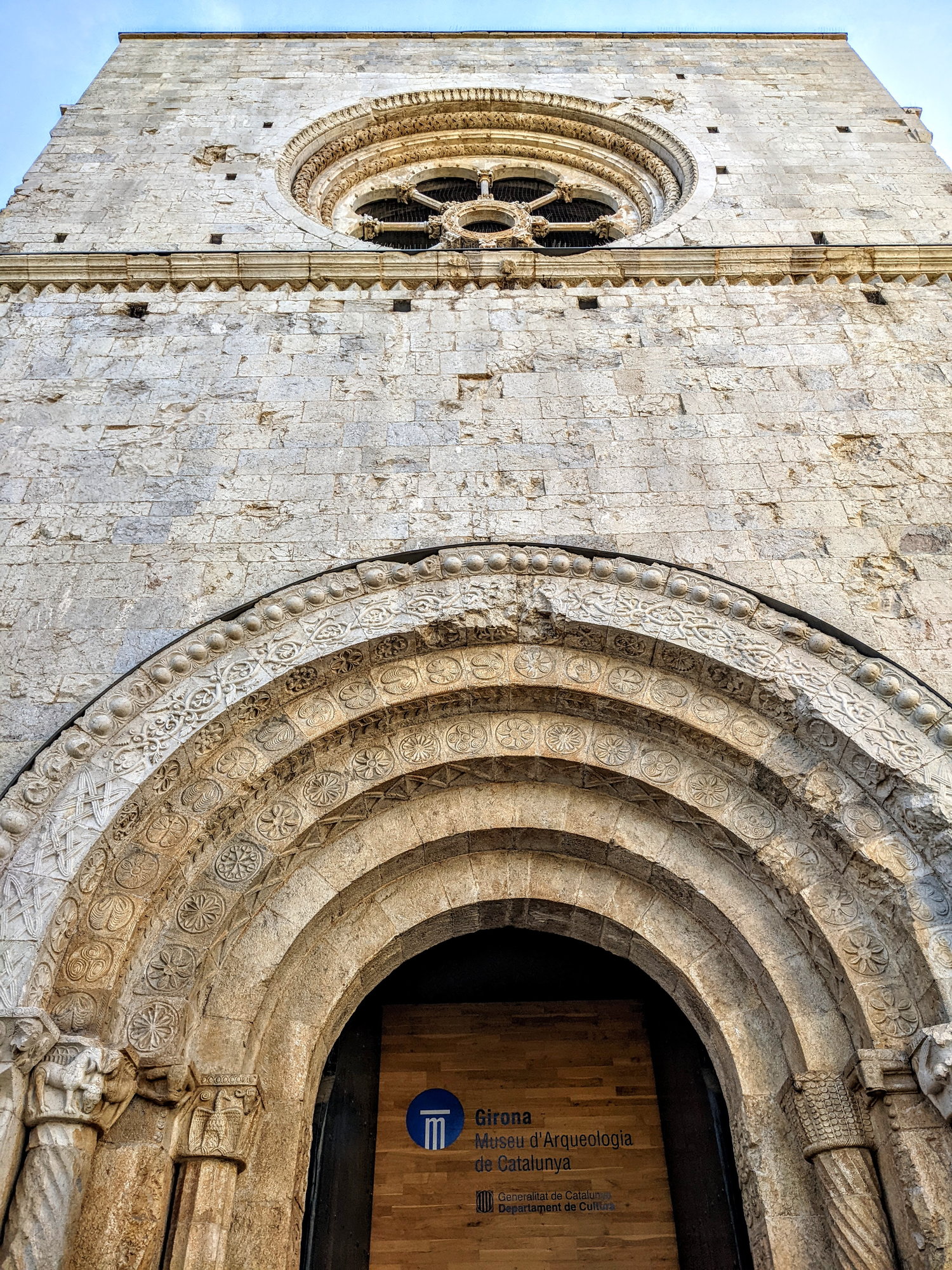
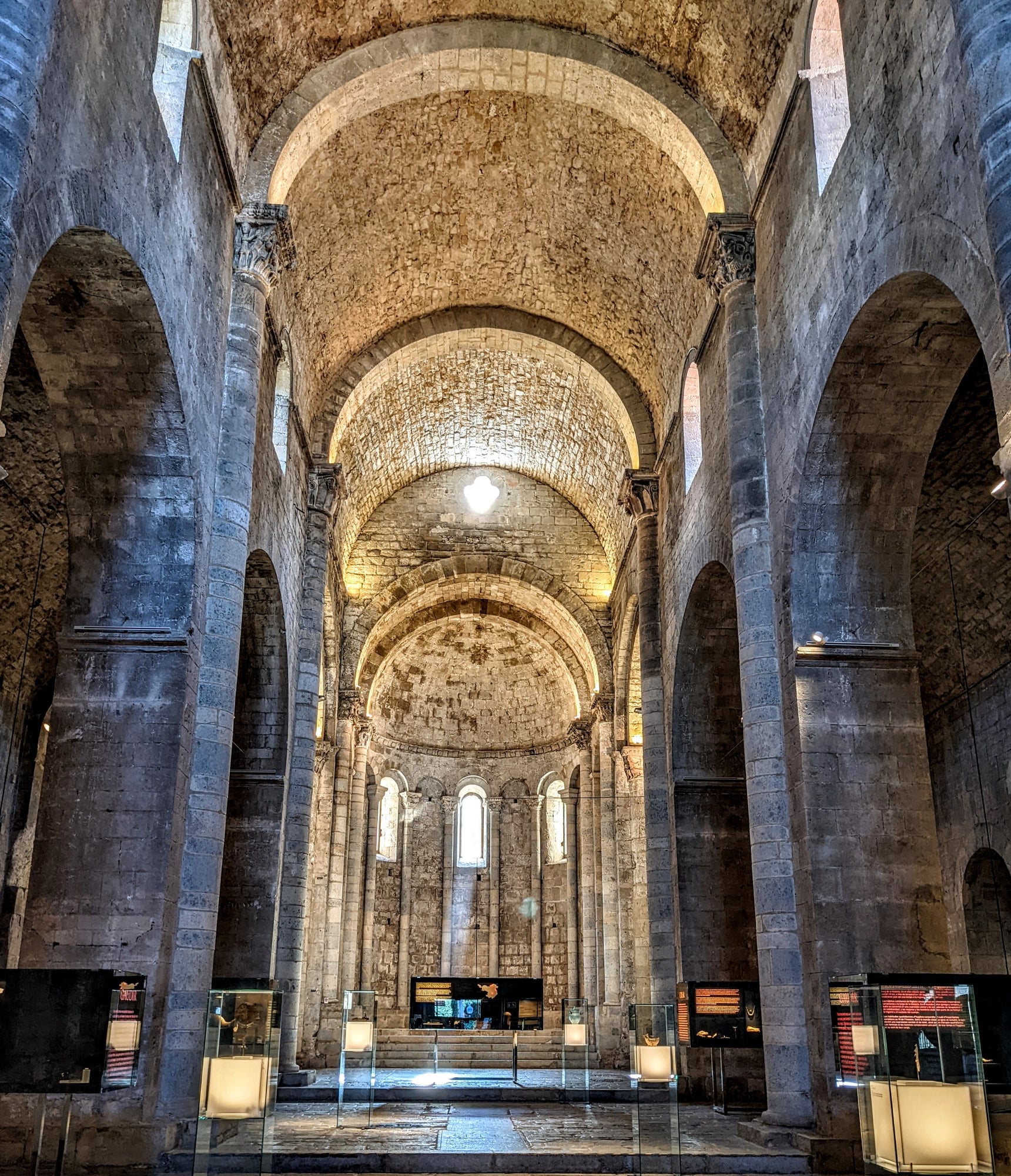
The cloister has sixty columns, with capitals that are even more complex than those of the cathedral cloister.

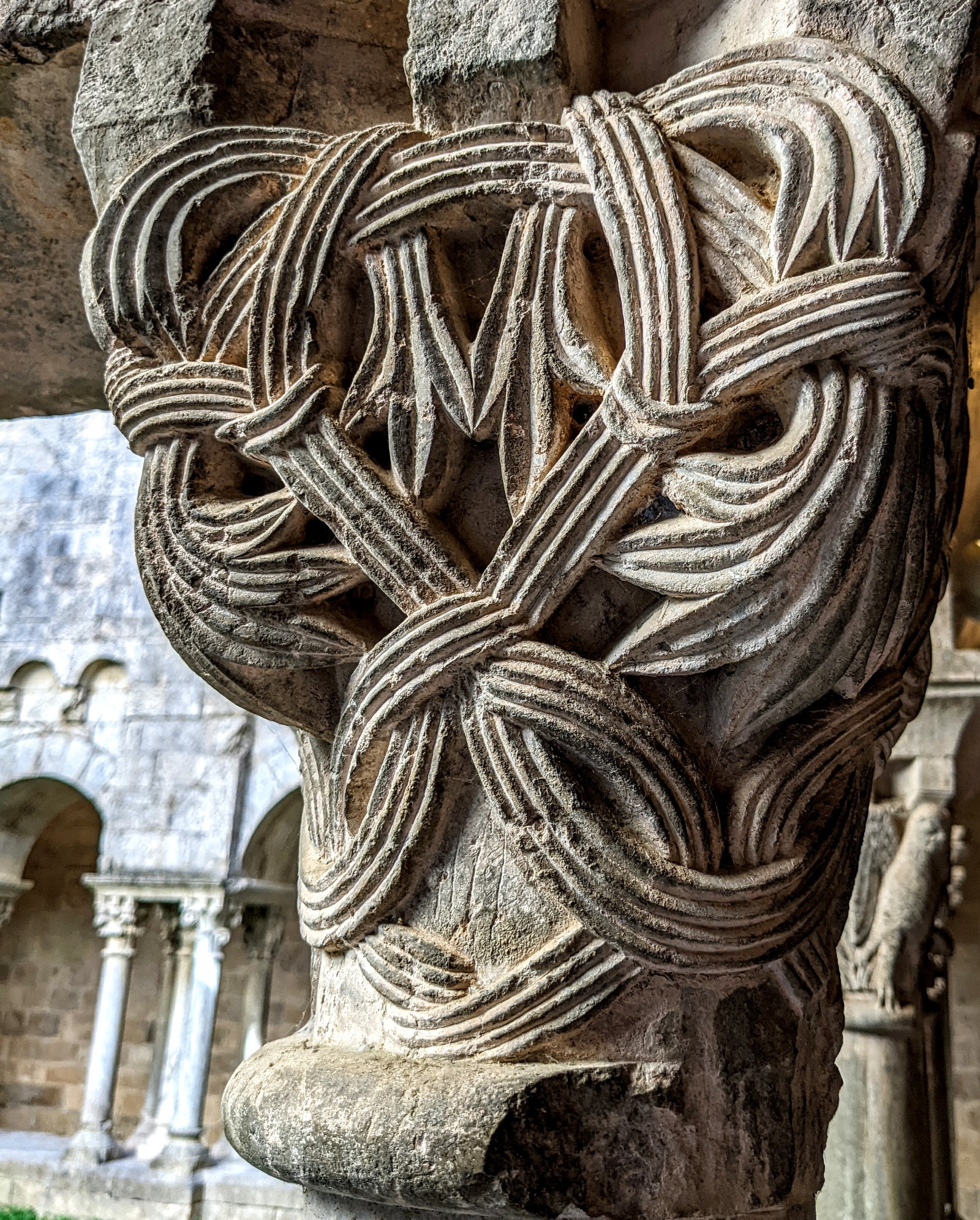
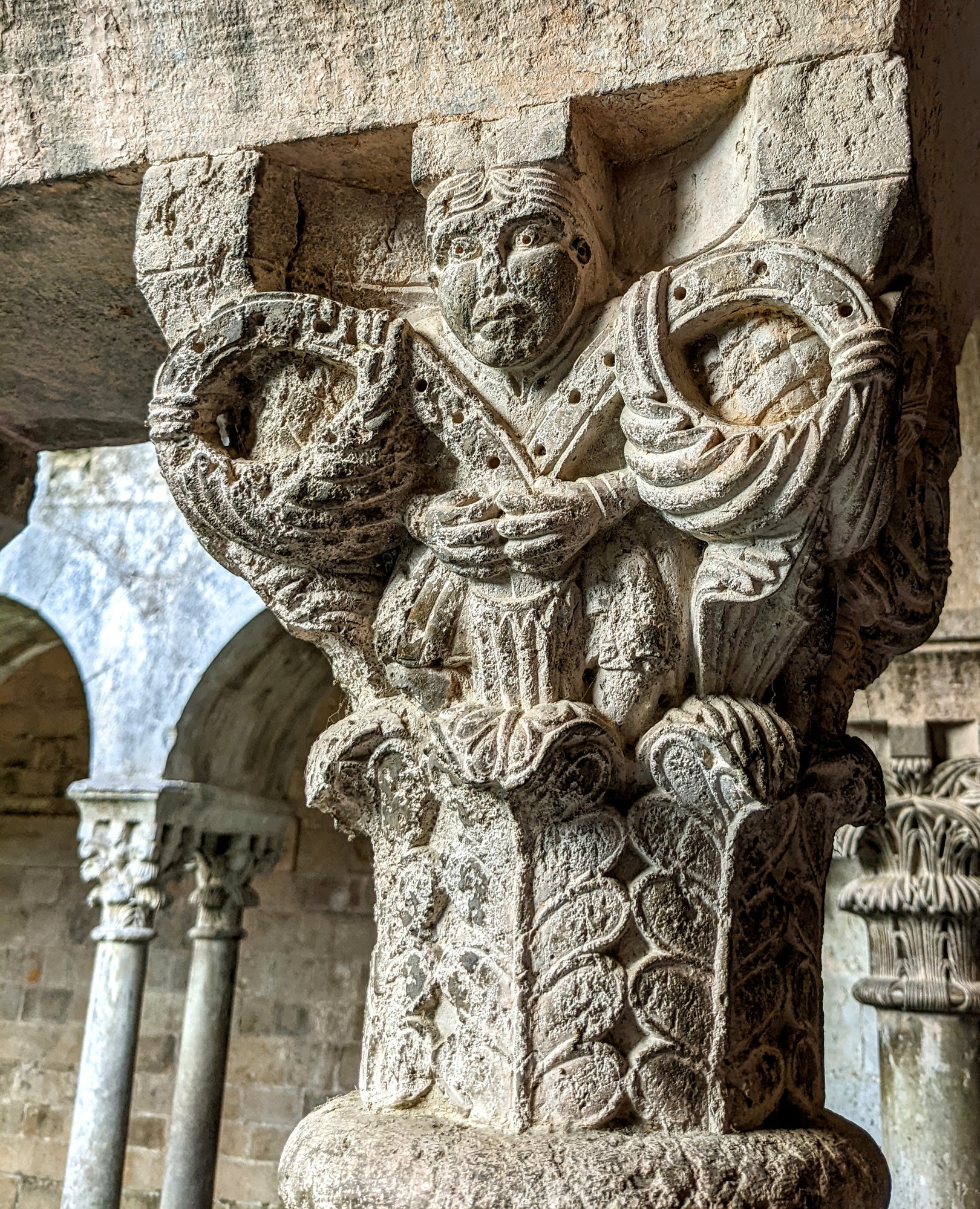
The church and the attached buildings house the Catalonia Museum of Archeology, a true treasure trove. Paradise for history nerds. The collection has objects going all the way back to the paleolithic and neolithic periods. They come from excavations throughout Catalonia. The Roman objects are abundant, but we were especially interested in the Iberian collection, not knowing much if anything about the Iberian culture. The Romans demolished the Iberian culture, as they did the Etruscan, but a fair amount of evidence survives, including items with Iberian writing.

Serving dish for fish, 4th cent. BC, Iberian period. The Iberians actually imported this dish from mainland Greece, showing the influence of the Greeks, who were already establishing colonies on the Catalan seacoast.
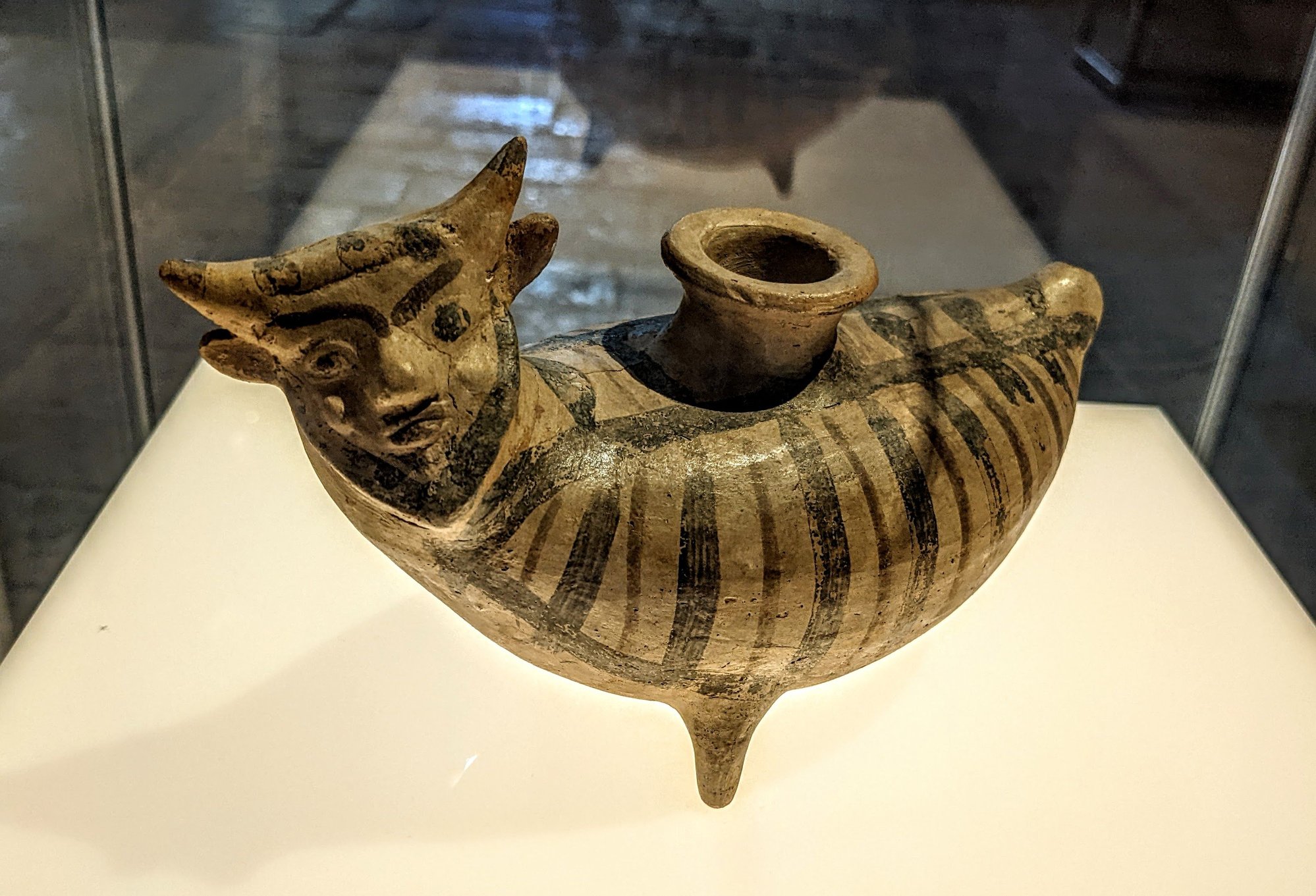
Oil jar, 5th cent. BC; the museum sign says this is from a Greek workshop in one of their towns in the western Mediterranean area, possibly Marseilles
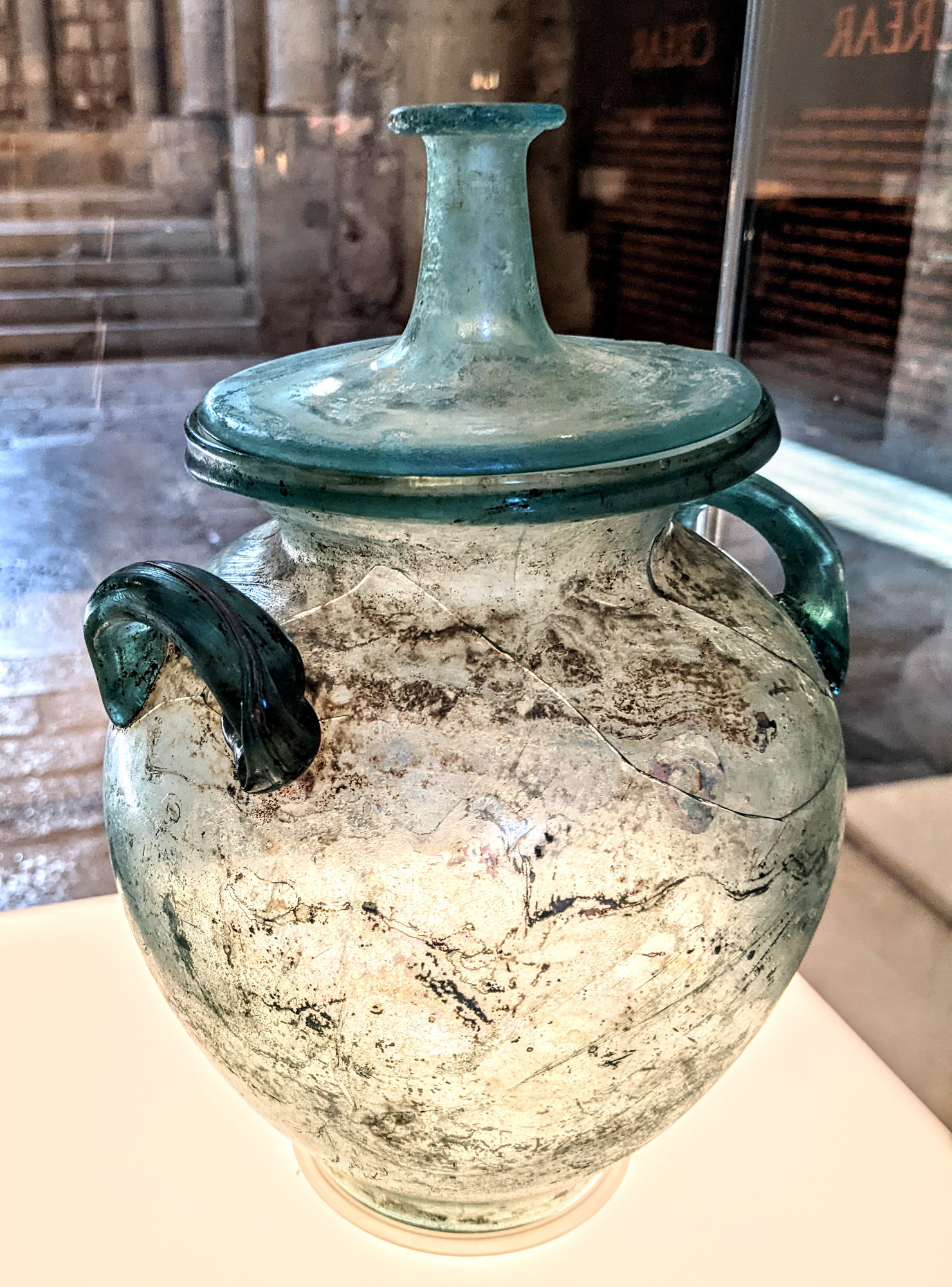
A Roman glass urn, 1st cent. BC

Ceramic vase, Greek colonization period, 5th cent. BC
After three very pleasant days in Girona, it was time to leave for the last part of our trip, returning to Barcelona for two nights. We went to Girona's new high-speed train station not far from our hotel, hopped the train and 40 minutes later we arrived at the Sants station in central Barcelona.

About to hop on the fast train in Girona's sparkling, shiny station--what a great system!
Concluding observations on Girona: not to be repetitive, but what a fascinating and under-appreciated city. If I were a digital nomad looking for a comfortable, vibrant place to live, this would be it.
Next and concluding bit: our two final nights in Barcelona


The cloister has sixty columns, with capitals that are even more complex than those of the cathedral cloister.



The church and the attached buildings house the Catalonia Museum of Archeology, a true treasure trove. Paradise for history nerds. The collection has objects going all the way back to the paleolithic and neolithic periods. They come from excavations throughout Catalonia. The Roman objects are abundant, but we were especially interested in the Iberian collection, not knowing much if anything about the Iberian culture. The Romans demolished the Iberian culture, as they did the Etruscan, but a fair amount of evidence survives, including items with Iberian writing.

Serving dish for fish, 4th cent. BC, Iberian period. The Iberians actually imported this dish from mainland Greece, showing the influence of the Greeks, who were already establishing colonies on the Catalan seacoast.

Oil jar, 5th cent. BC; the museum sign says this is from a Greek workshop in one of their towns in the western Mediterranean area, possibly Marseilles

A Roman glass urn, 1st cent. BC

Ceramic vase, Greek colonization period, 5th cent. BC
After three very pleasant days in Girona, it was time to leave for the last part of our trip, returning to Barcelona for two nights. We went to Girona's new high-speed train station not far from our hotel, hopped the train and 40 minutes later we arrived at the Sants station in central Barcelona.

About to hop on the fast train in Girona's sparkling, shiny station--what a great system!
Concluding observations on Girona: not to be repetitive, but what a fascinating and under-appreciated city. If I were a digital nomad looking for a comfortable, vibrant place to live, this would be it.
Next and concluding bit: our two final nights in Barcelona



